Painting my Daughter's Cranial Band
Project Overview:
For those who don’t have babies, sorry that so many of my recent posts are baby related. I can’t help it – she’s adorable. Recently she was prescribed a cranial band (Doc Band) to correct a flat spot on the side of her head. Nearly 1 in 2 babies develops a flat area on their heads medically known as plagiocephaly. Although flat spots do not affect brain development and are sometimes considered cosmetic, they can impact the way helmets, glasses, or other safety equipment fit. Because our little one also wears glasses and has some facial asymmetry, it was worth it for us to get the band. Hopefully, it will only be a few months and then she will be done!
You can see the helmet comes in a very clinical white.


THE PROCESS OF GETTING A HELMET
Getting a helmet was not particularly difficult. For some companies like Cranial Technologies (Doc Band) you don’t even need a referral, you can just set up a free consult. We arrived, and the put a knit stocking on our daughter’s head and took some 3D pictures using multiple cameras. In a few seconds we had a 3D scan of her adorable, slightly smooshed head.
I should note – if your insurance doesn’t cover it, these things are NOT cheap and can cost thousands. We have already met our out of pocket maximum for the year (giving birth is pricey) so we were covered.
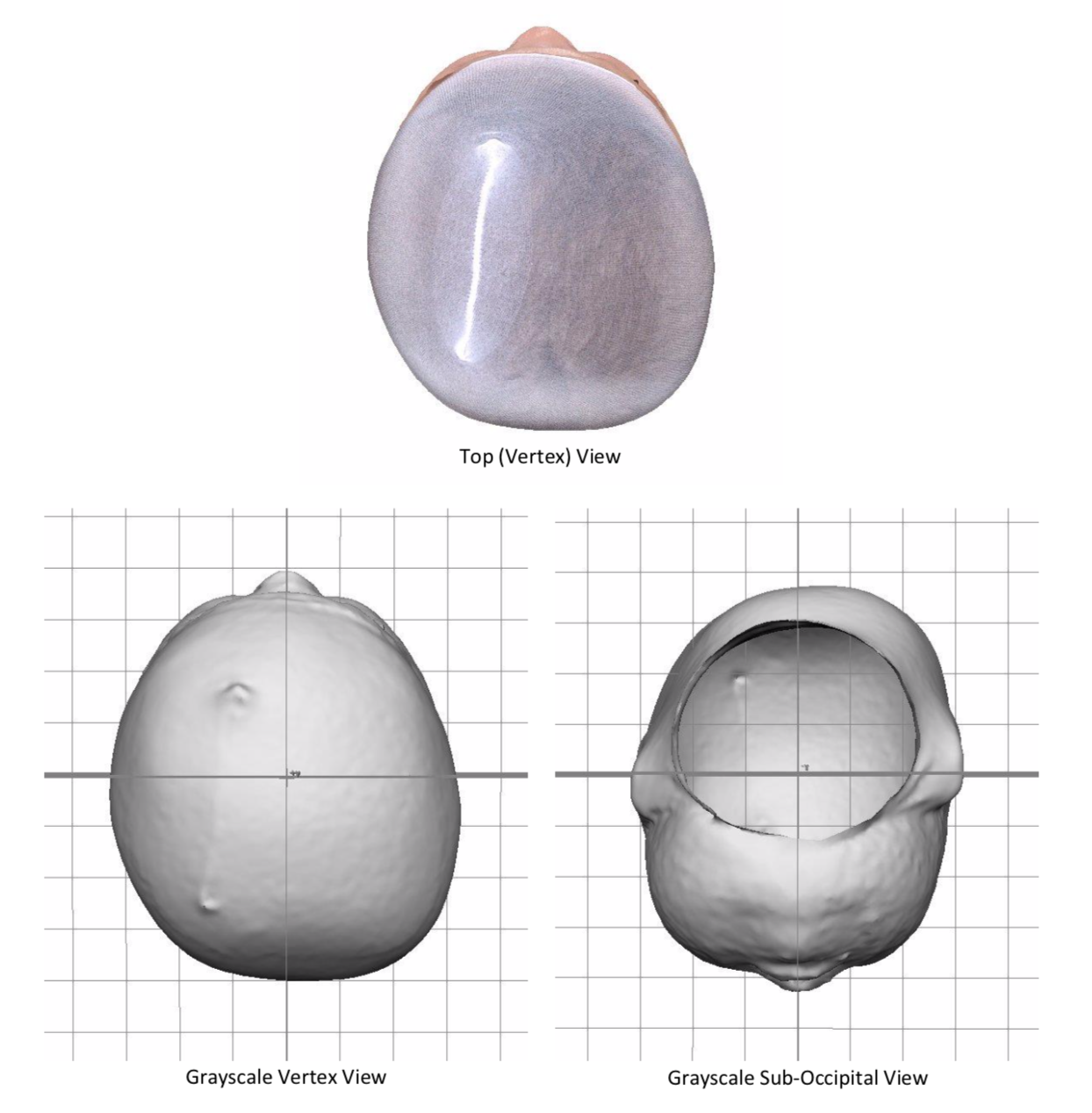
THE SCAN
So you can see above that her head shape isn’t quite right. She has lots of hair so it’s not super obvious in person, but our hope is evening it out will help make her glasses fit better and maybe even help make her “smaller” looking eye appear more even.
Below you can read her measurements. You can see the asymmetry measurements are considered “severe”. The goal is to reduce these numbers over the coming weeks.
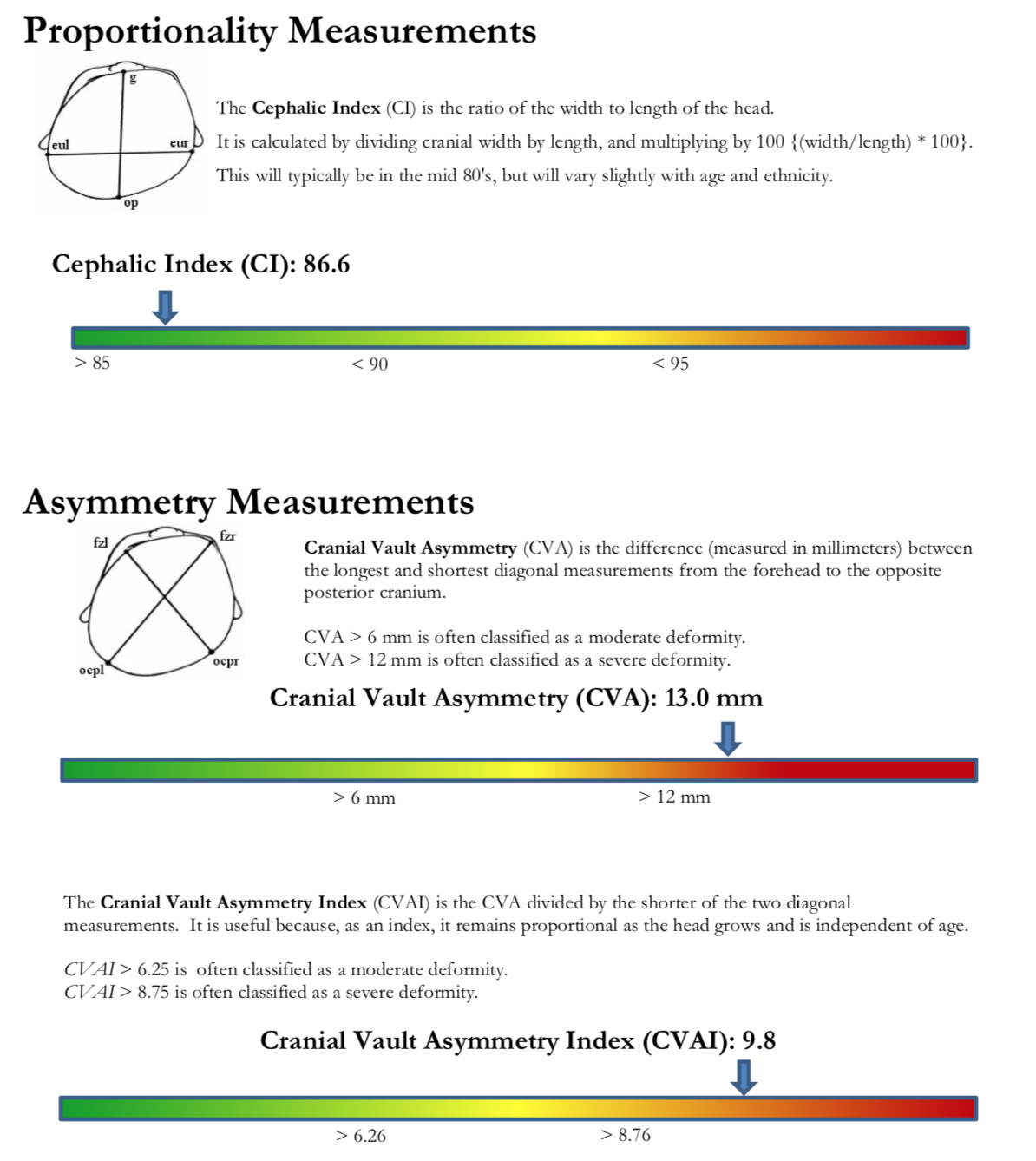
I was really surprised to see she was considered severe. At 6 months old she is getting into the upper window for treatment. Babies can be treated as late as about 10 months I believe but results are better the sooner you start because the helmet works with the baby’s growth spurts. The helmet is not designed to press the skull into shape – instead the head grows gently into the voids in the helmet to create a more even shape.
THE ADJUSTMENT PERIOD
During her initial fitting Diana screamed bloody murder the whole time, but by that evening she wore the helmet like a champ and has no issues with it other than it makes her want to sleep on her face (which is terrifying to see on the baby monitor. The thickness of the helmet leaves a gap so I know she can breath but Lord…
After her helmet arrived, there are a few days of modified wear. This means she wore the helmet for a few hours on and then an hour or so off to check for any pressure points or red spots. In the case that any red spots do not go away within an hour you will need to go back to have that area shaved out of the helmet. For the first couple days she wasn’t required to sleep in the helmet either. This modified wear time is the perfect opportunity to decorate the helmet.
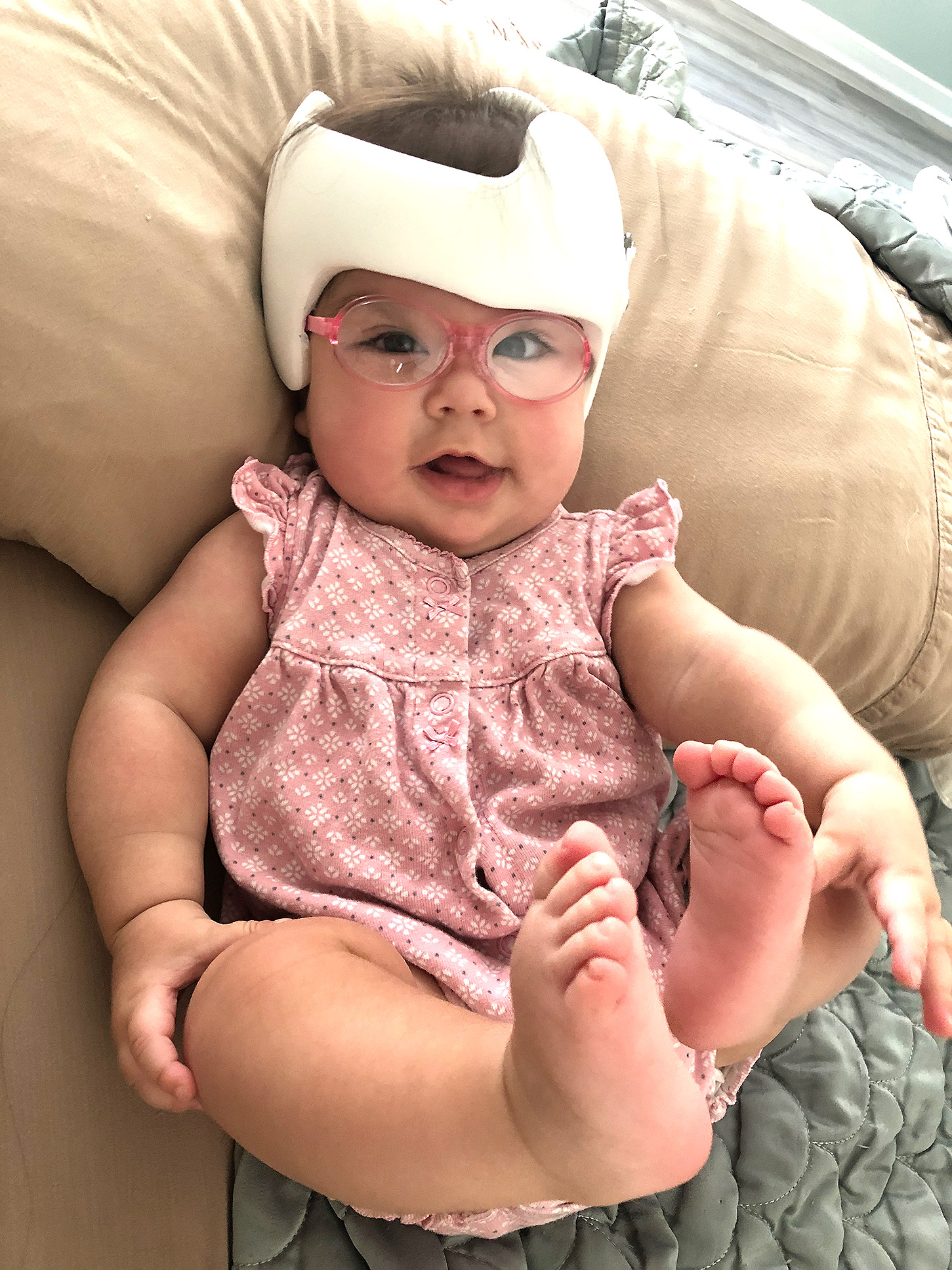
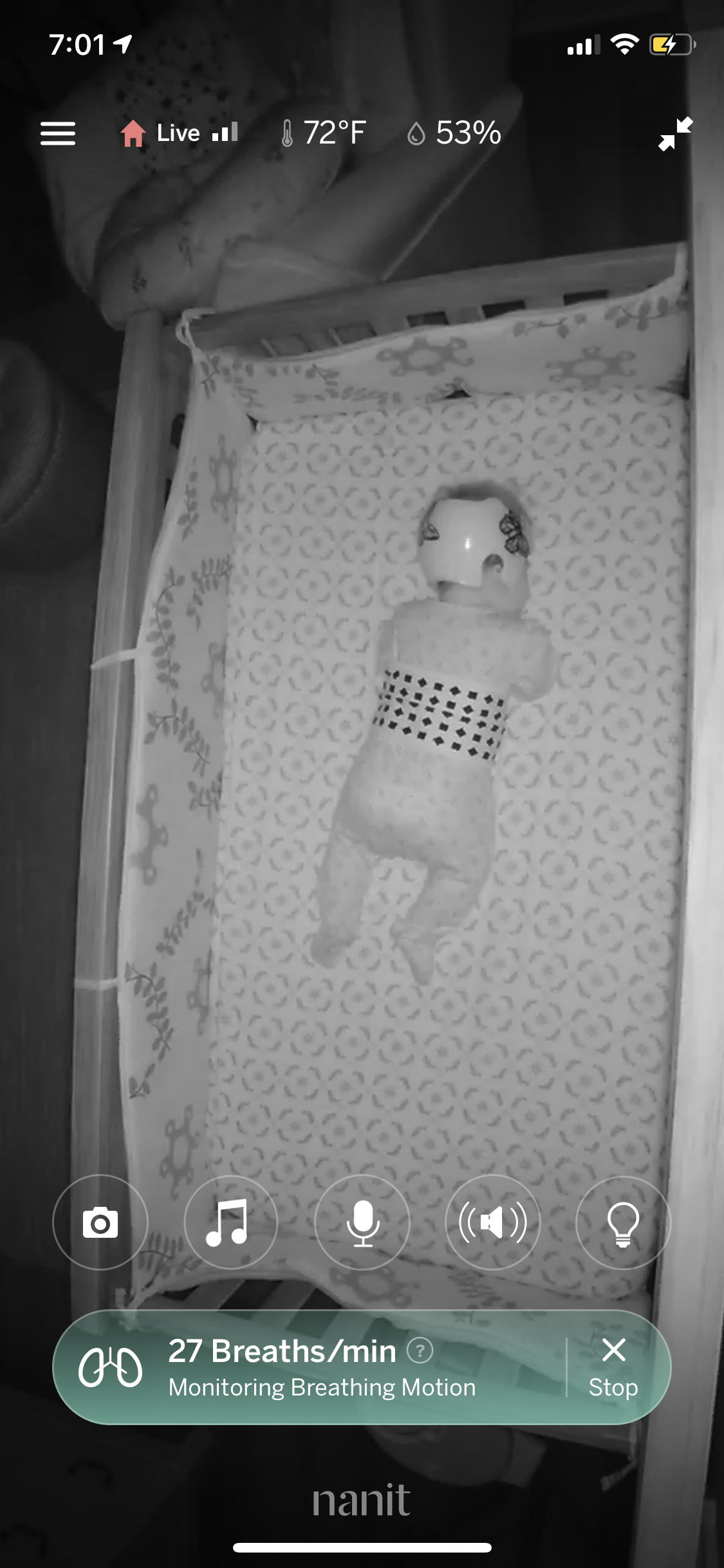
DECORATING OPTIONS
There are three main options for decorating your helmet.
- Vinyl Decals, stickers, or appliques – This is the easiest option for DIYers who don’t like to paint or draw. You can purchase a ton of designs from Bling Your Band. You’ll want to get some Modge Podge to seal in your decals and you can always paint a base color if you’d like.
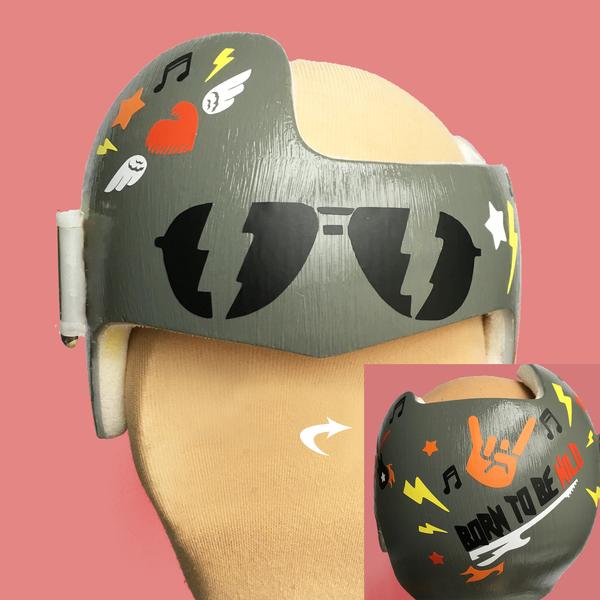
2. Professional Graphic Wrap – If you’re a graphic designer or know one you can design a custom graphic wrap and have a car decal place print and apply it. This is probably the mid priced option as you will be paying for print and install, but it will be seamless, beautiful, and very durable. Any place that wraps vehicles should be able to do this, and I believe some do the install free because they’re nice like that.
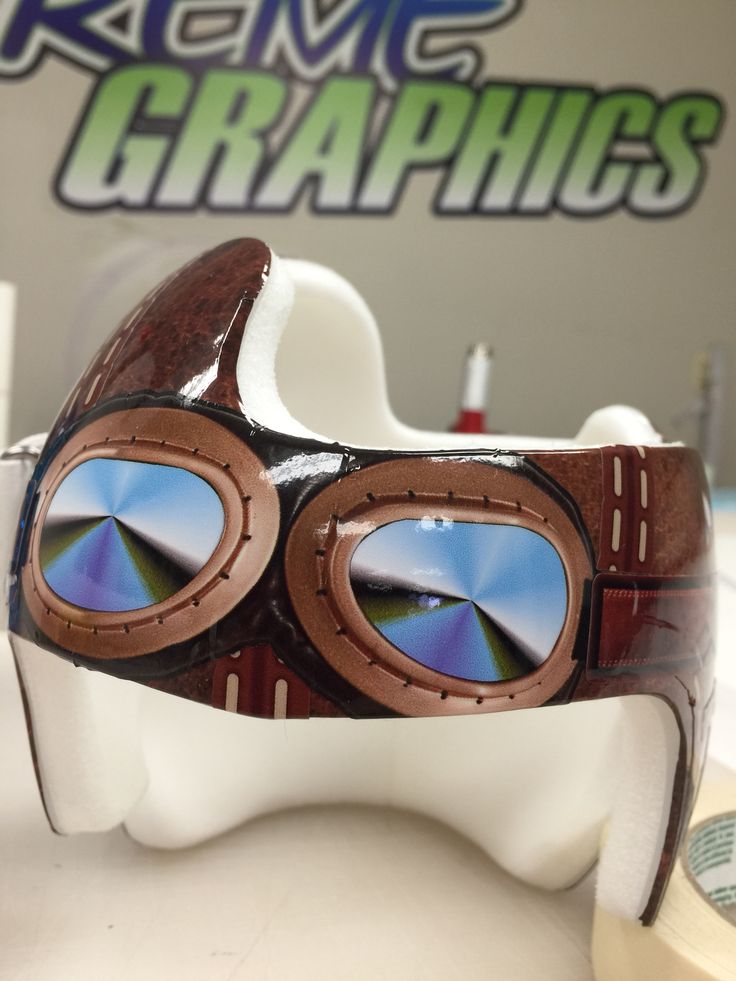
3. Paint It – If you’re comfortable drawing or painting freehand then this is the easiest choice. Some people send their helmets off or find a local painter as well. The companies don’t recommend sending this (very expensive) piece of medical equipment off though because it delays treatment and if they ruin it you’re SOL. If you are paying an artist to paint this it’ll be the most expensive option often running between $200-400.
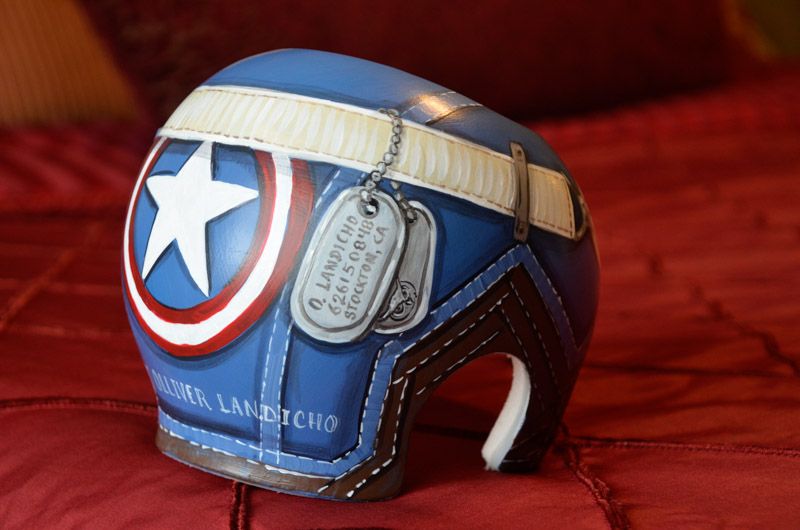
THE PAINTING PROCESS
STEP ONE: SANDING
The first and often most important step is prep. The helmet has a shiny, slick finish which we need to gently buff away so that our paint will stick. Use a very fine sandpaper – you don’t want to actually remove any significant amount of material, you’re just getting rid of the shine. 5-10 minutes of all over sanding reversing directions should be good. I used a sanding block, as this was the easiest to use.
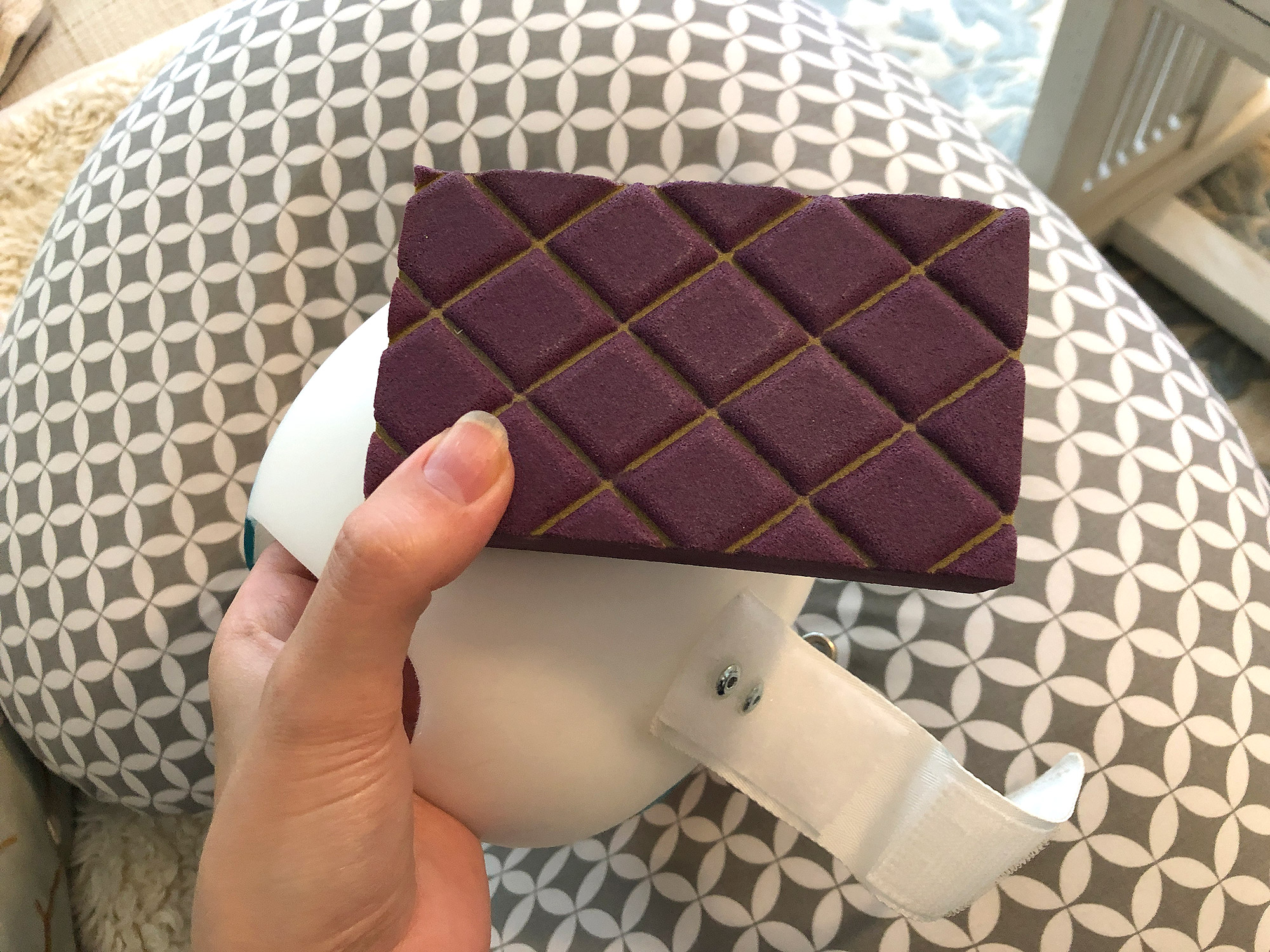

If you do not sand, you’ll find that your paint beads up and won’t stick. One trick is to minimize the amount of water you use, you want to use the paint “pure” not watered down. Secondly, make sure you sand the edges of the helmet as well. See below how the paint is pulling together? We want to avoid that by making a nice matte surface and minimizing water.
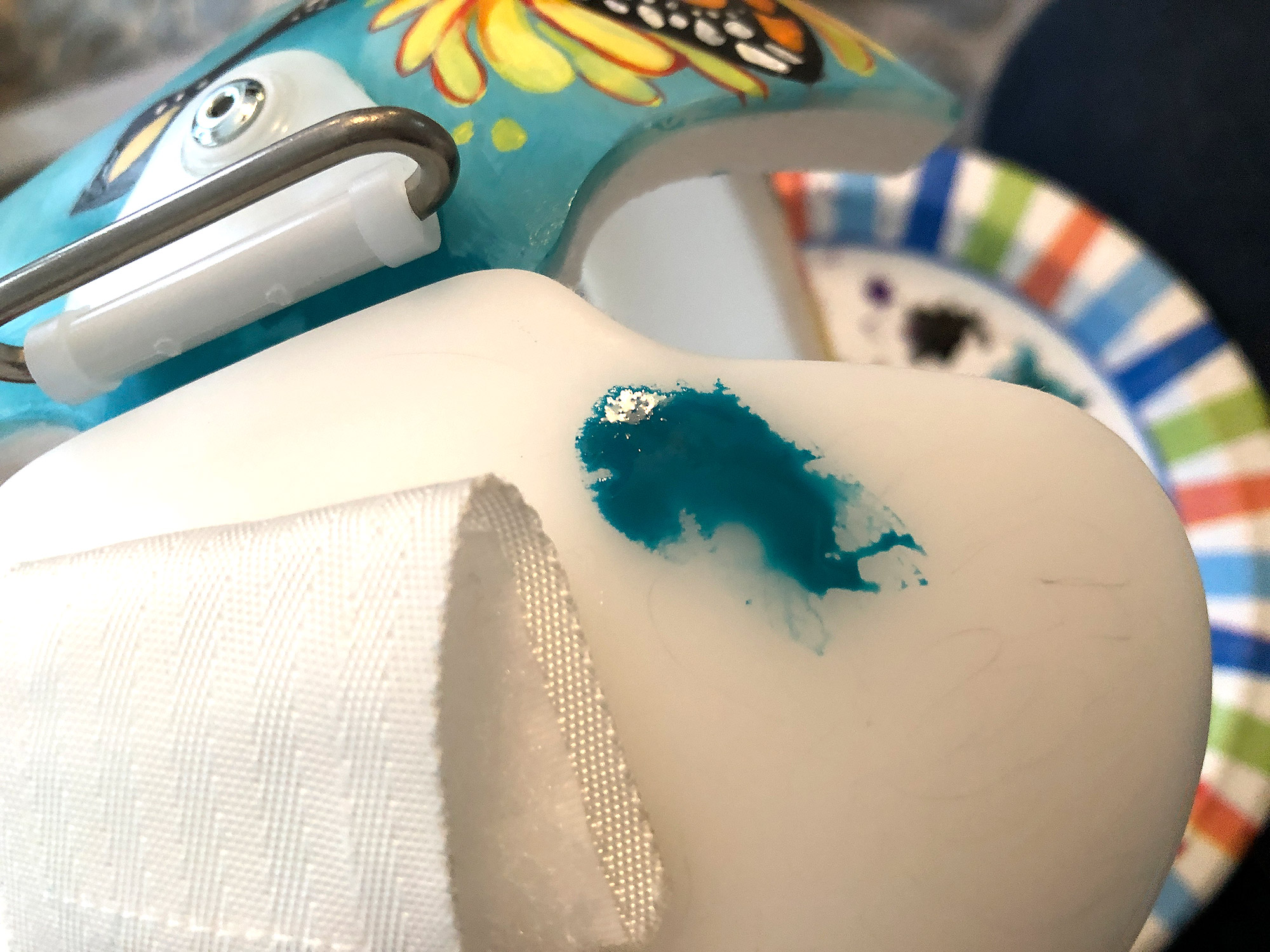
STEP TWO: MATERIALS
You will need three basic materials – acrylic paint, Modge Podge, brushes (and sandpaper from the previous step). My recommendation is to use higher quality paint if you can afford it. I know many people use cheap .50 cent acrylic from the craft store – but it tends to be translucent, and doesn’t have the density of pigment and adhesion properties of better paint. I have a lot of pricey paint – I have a degree in Illustration so I’ve collected some nice stuff over the years. I wanted something very pigmented so I used Liquitex’s Acrylic Gouache. I also had some Golden Acrylics. These pricier paints were worth it for me because I use them all the time for other projects.
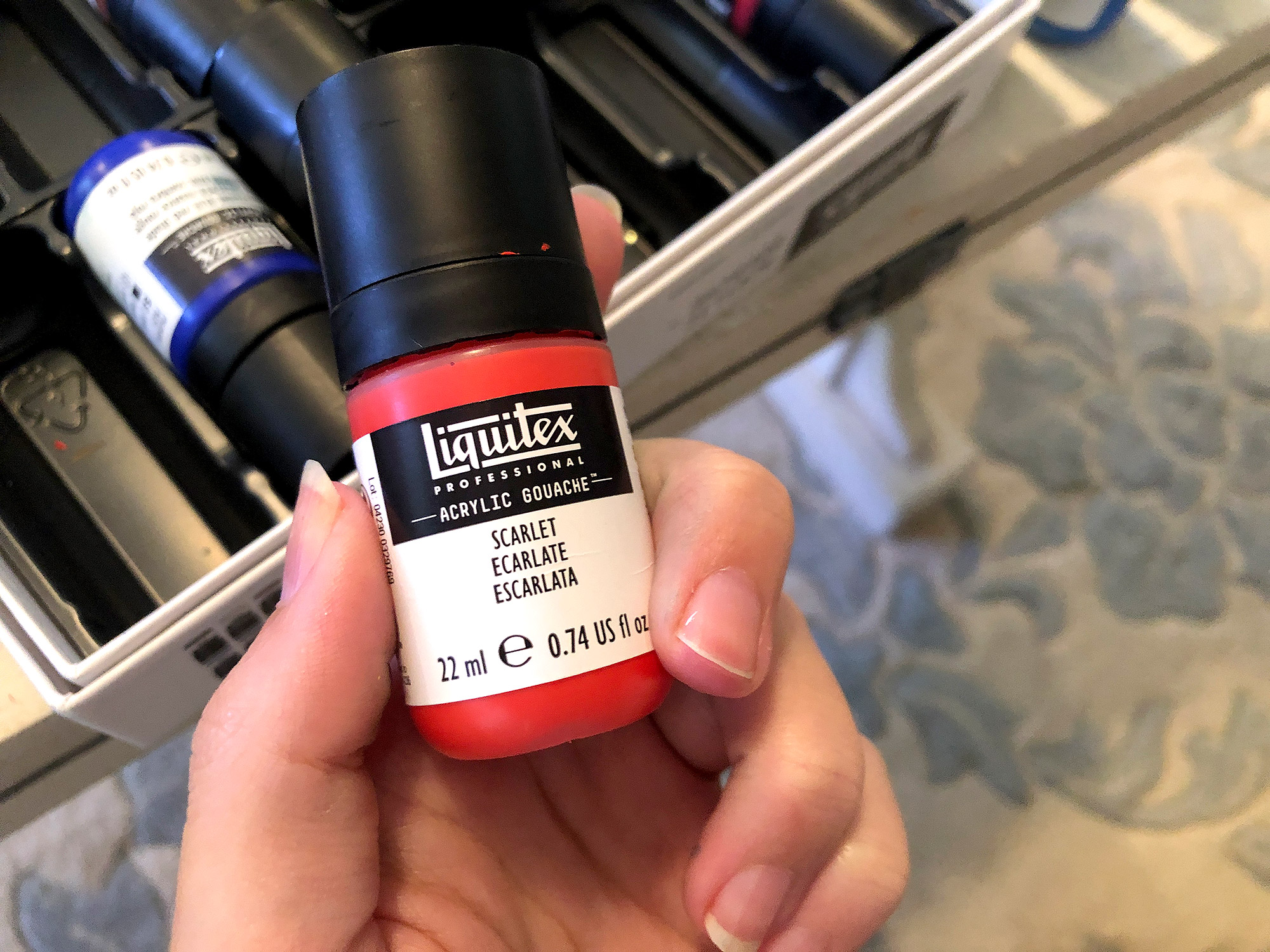
Liquitex Acrylic Gouache is very opaque making it perfect for this application. The colors and desne and super matte – so you get a nice finish.
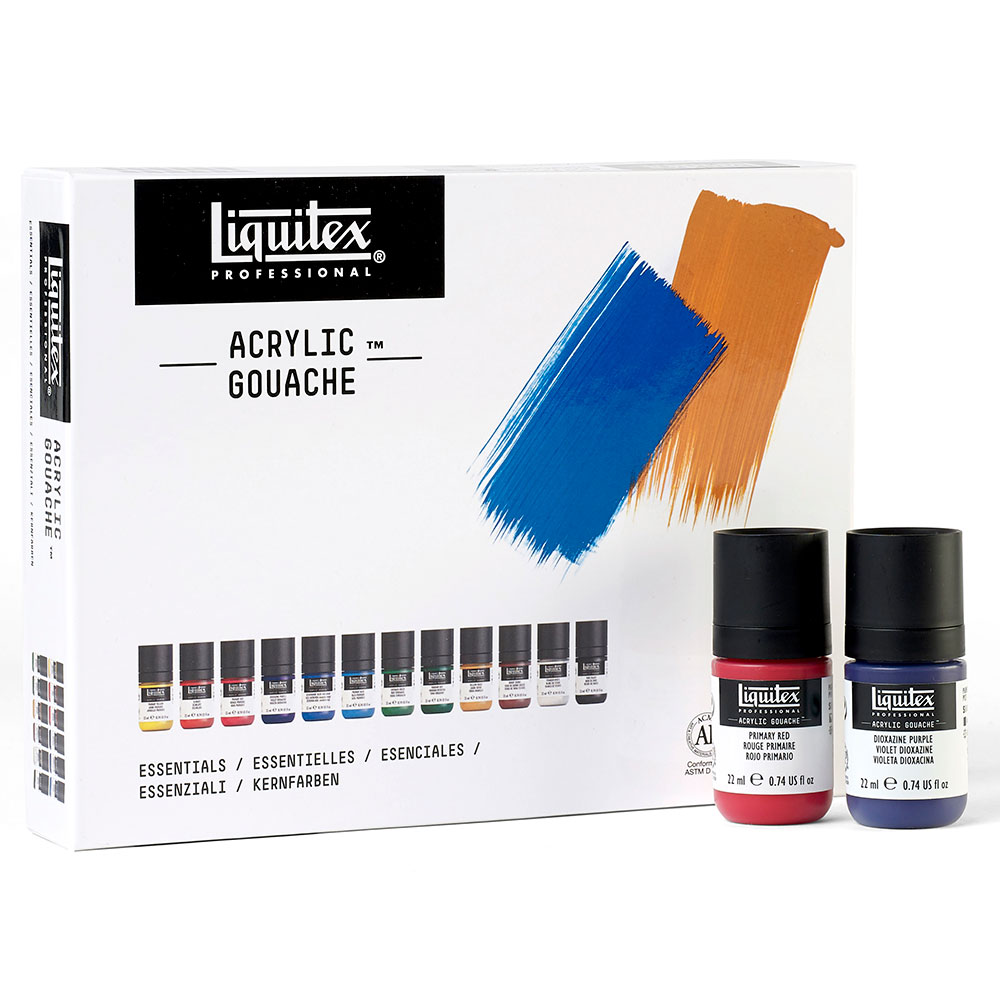
I also used some Golden Fluid Acrylics – these are great for layering overtop as they are much more transparent – they are not ideal for painting the base color on your helmet. I LOVE these acrylics for a ton of different applications but in this context they are only useful for glazing transparent layers of color to build depth.

For sealing in your paint you will want to use something safe and water-based. Modge Podge is ideal because it is thicker than most other varnishes.
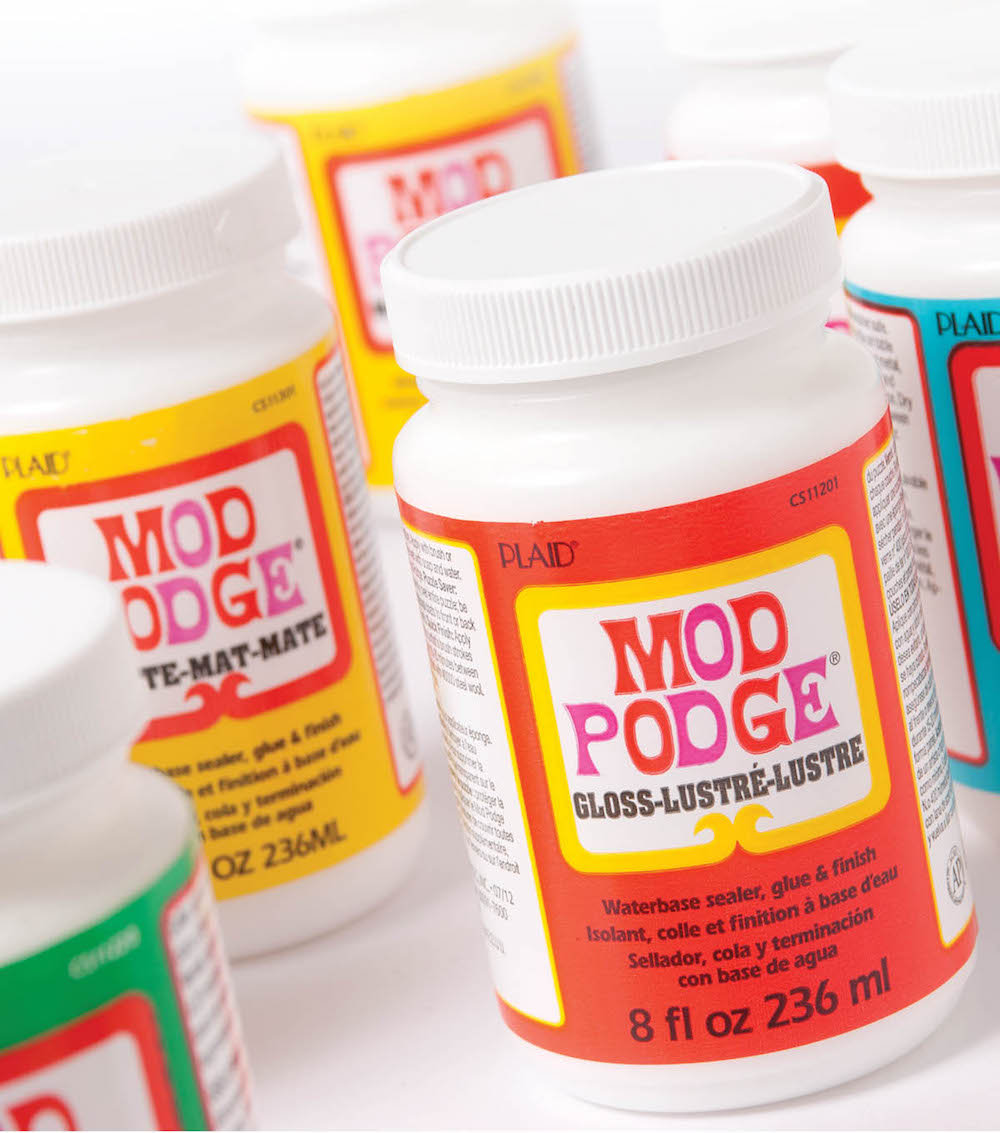
STEP THREE: SKETCHING THE DESIGN
There are two ways you can do your design and I tried both. For the front of the helmet I just sketched the design in pencil and began painting. For the back of the helmet I painted the base color first, then sketched elements in acrylic and painted over. To be completely honest. I free-handed the design for the most part, just painting whatever wherever I felt like it. I’m sorry that’s probably not super helpful, but I wanted to get this done ASAP so she wouldn’t have delayed treatment so I raced through the process.
If you’re more comfortable drawing on paper you can draw your design on paper and use transfer paper to apply the design to your helmet. I don’t have or use transfer paper usually so you’ll have to Google it if you want instructions on that but basically, it’s a graphite coated paper, and wherever you press on it with a pencil or pen it will transfer the mark to the surface. Essentially you could print a design or sketch something out, hold it over the transfer paper, and re-trace with pressure to transfer your design.
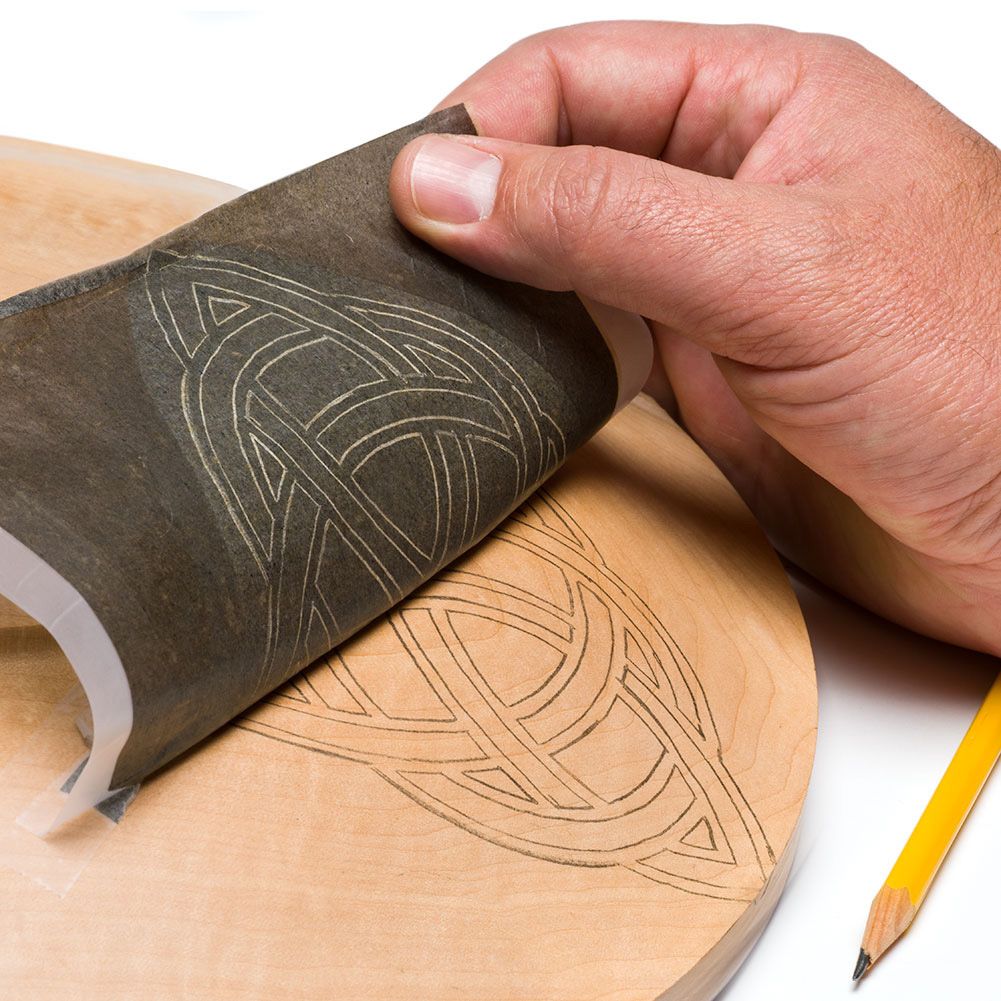
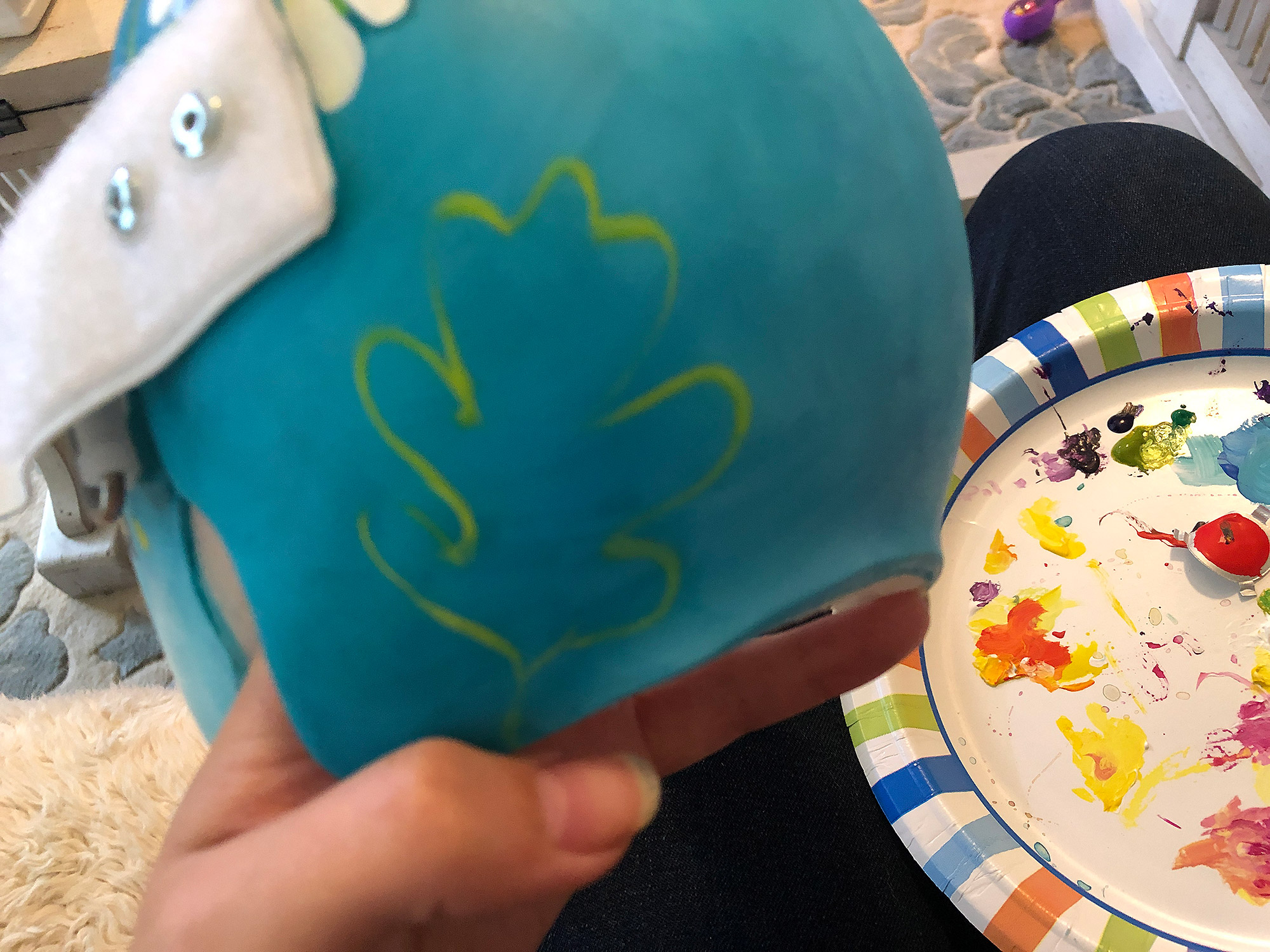
STEP FOUR: PAINTING THE BASE
I found the easiest method was to paint the entire helmet in a base color and then paint over top – my paints were opaque enough that the base color didn’t negatively affect how they looked.

I didn’t want an even flat color all over – so I use hatching strokes (criss-cross) and mixed the teal color as I went (this was just phthalo green, cerulean blue, and white). Some areas are slightly lighter and some darker. This gave it a painterly depth. Also, don’t forget to get those edges!
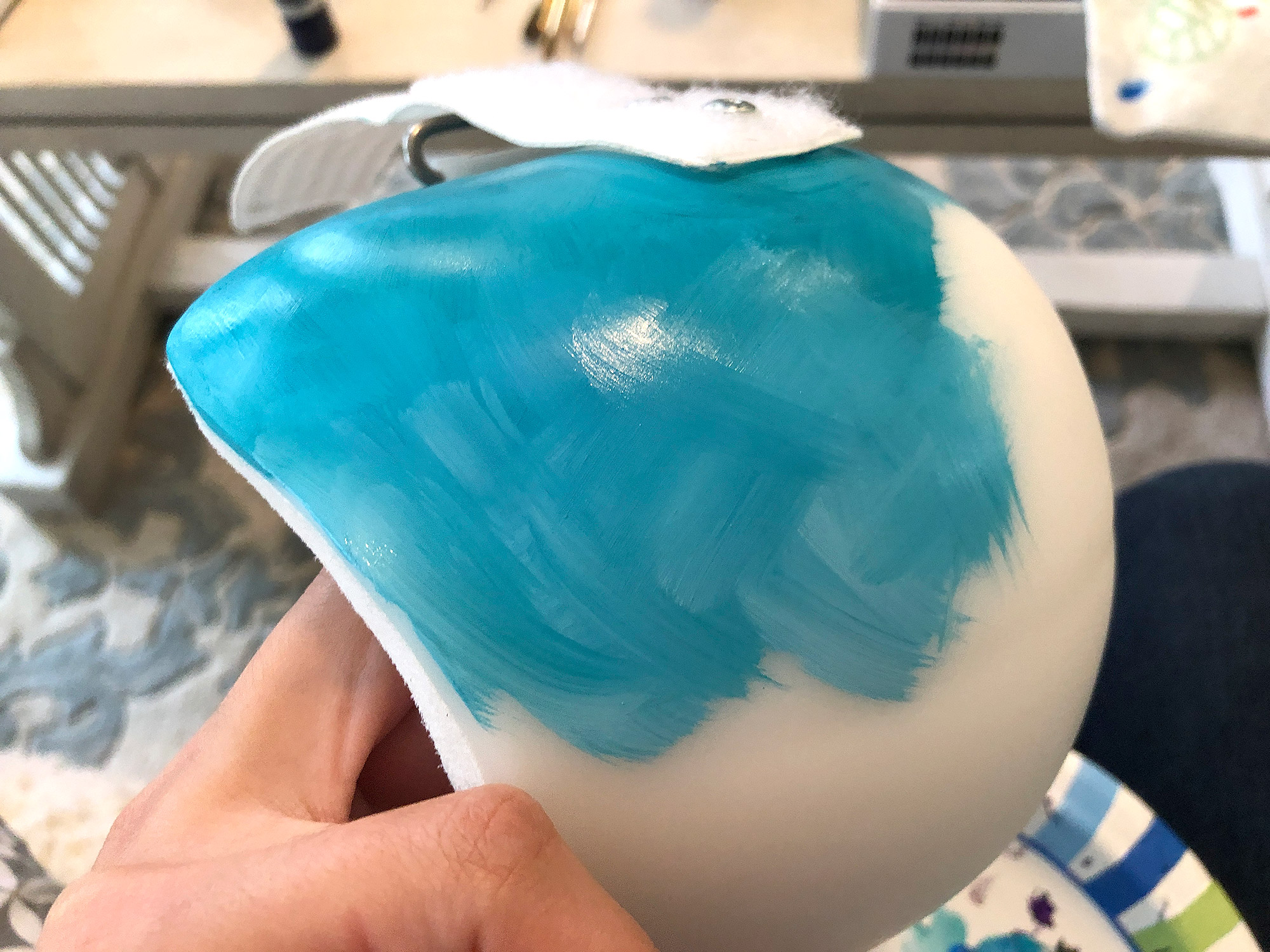
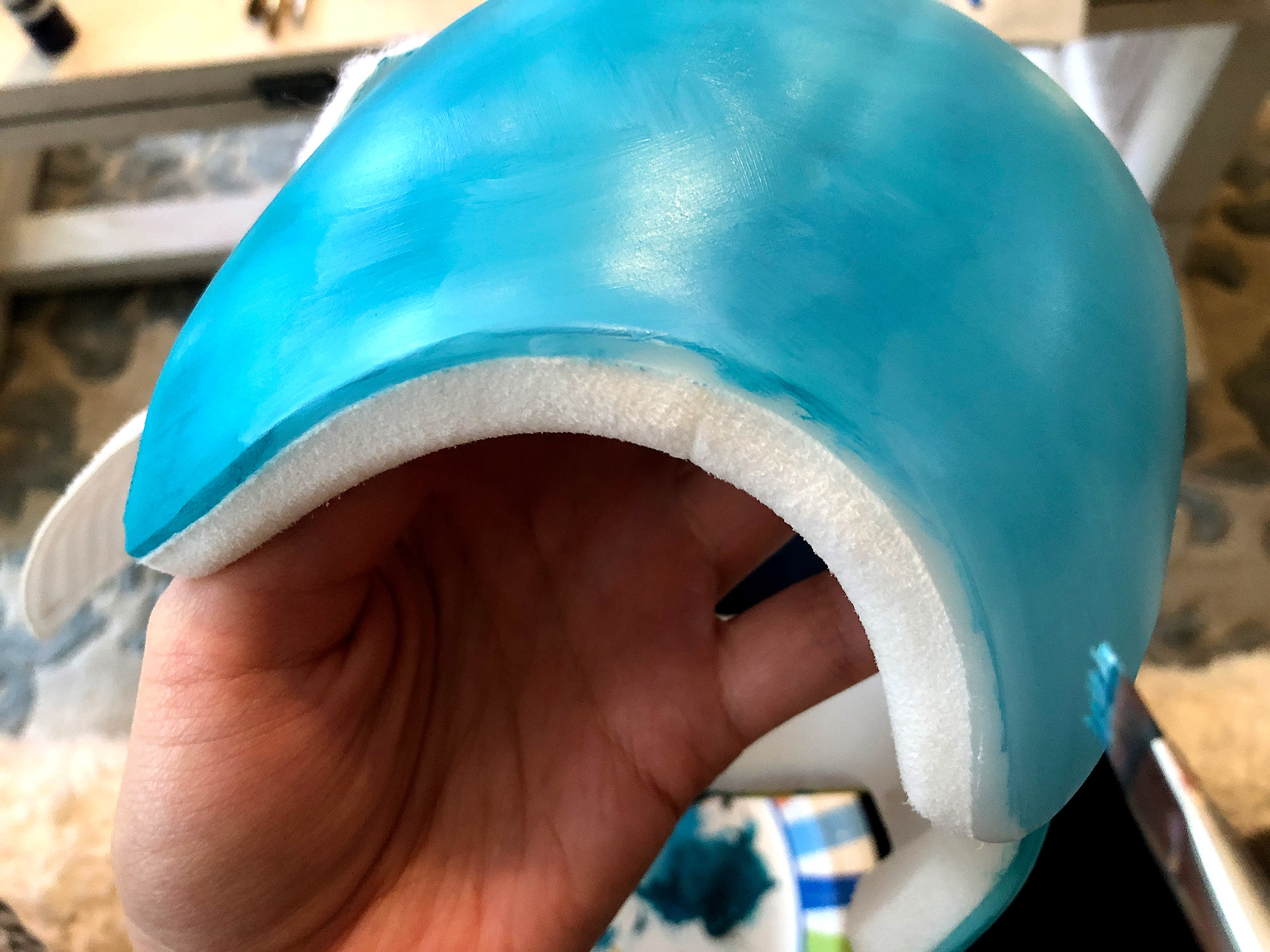
STEP FIVE: PAINTING THE DESIGNS
Work in layers and let the layers dry before going back or you may pull away pigment (see the circled section below). Since the paint just sits of the surface of the band and doesn’t absorb in (like it would with paper or canvas) we need to let each layer dry enough that we don’t reactivate it or disturb it with the next layer of paint.
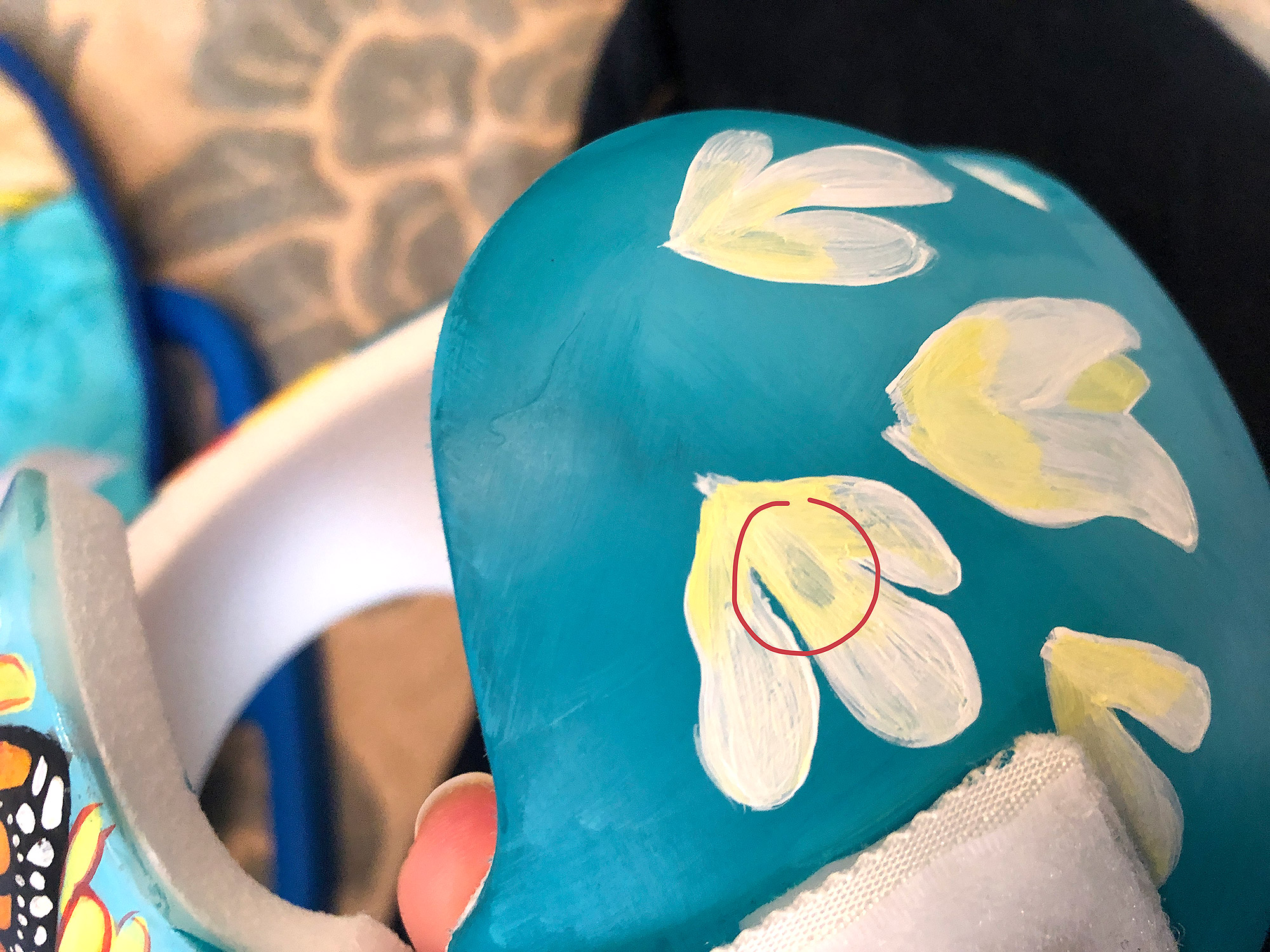
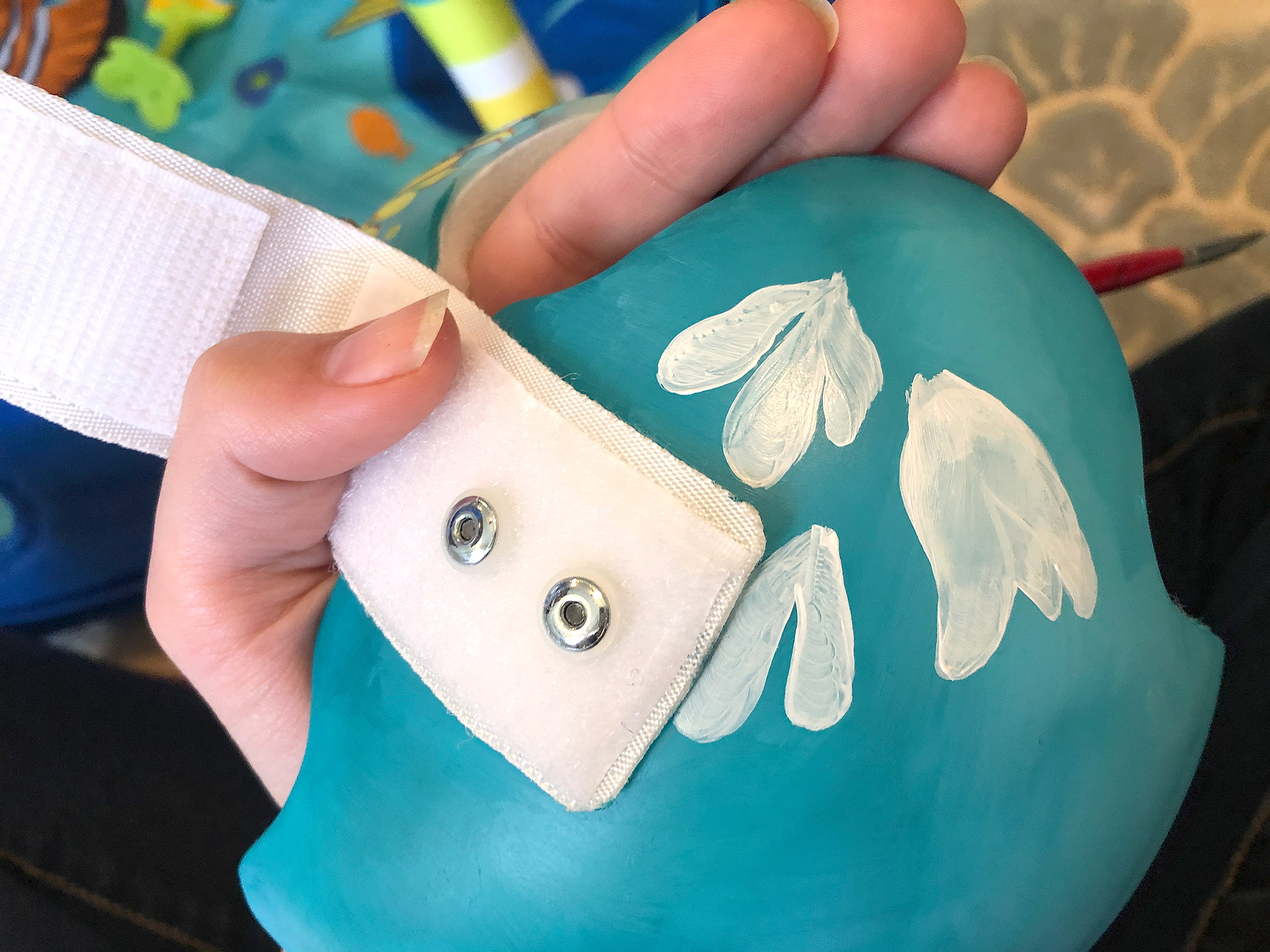

Below you can see I’m not too precious about making every color perfectly even (especially the background). I like to see the brush marks as it leaves some evidence of the process and adds interest. You can also see how intense and opaque the Golden Acrylic Gouache paints are.

My biggest cost here was the paint itself. I used cheap brushes, a paper plate as a palette and an old yogurt cup as my water dish. My brushes are so cheap I don’t even feel bad about leaving them sitting in the water (which is bad for brushes and I never do it for my high quality ones). If you look at my paper plate palette you’ll see I didn’t use a ton of paint – this stuff goes a long way do not put huge globs of it on your palette or it’ll dry out and you’ll waste the precious material. I applied pea size amounts to my palette and just added more as needed. I probably used less than an Oz of paint total.
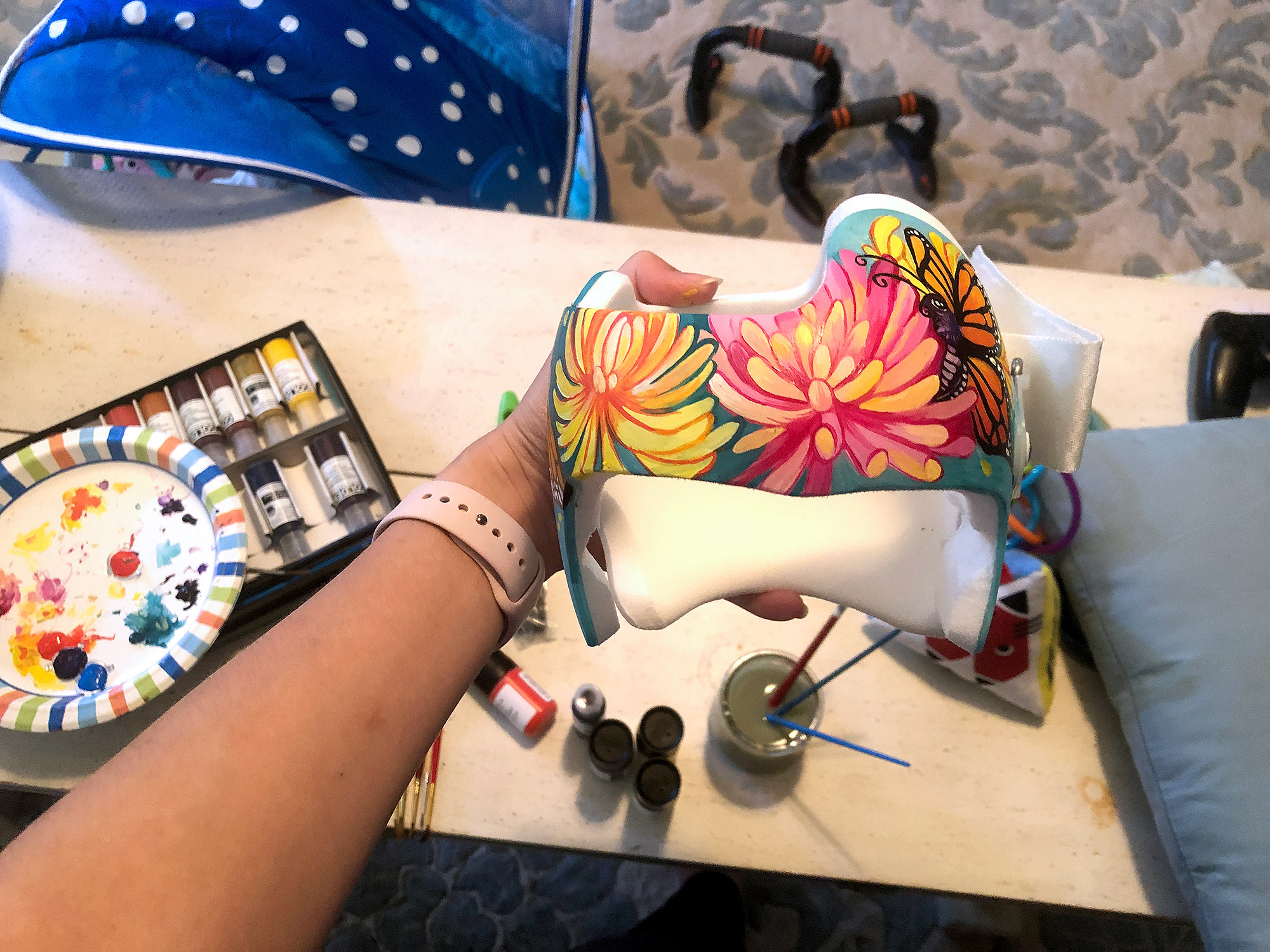
STEP SIX: PAINTING THE STRAP
The nylon/velcro strap in the final painting step. I decided I didn’t want to really do any designs on it, I just wanted it to blend in so I watered down my paint and brushed it on like a dye. I’ve seen lots of people paint their straps with undiluted acrylic and seal it with Modge Podge but I was worried about it cracking if applied to thick since this a flexible surface. On my second attempt (when my son later also needed a helmet) I found pure acrylic pain worked just fine.
My application needs a second coat as it was kind of blotchy. My advice would be to wet the strap with plain water first, this will allow the paint to flow better. I did not paint the velcro itself or the plastic buckle as that item was very slick and it rotates around so I didn’t want to bother with trying to sand it’s weird shape. The strap remains perfectly flexible with the way I’ve “dyed” it and although I may go back later and add a few snowflakes I’m fine with it as it is. You could do a nice blend from one color to another though, and that might look really neat on the strap.
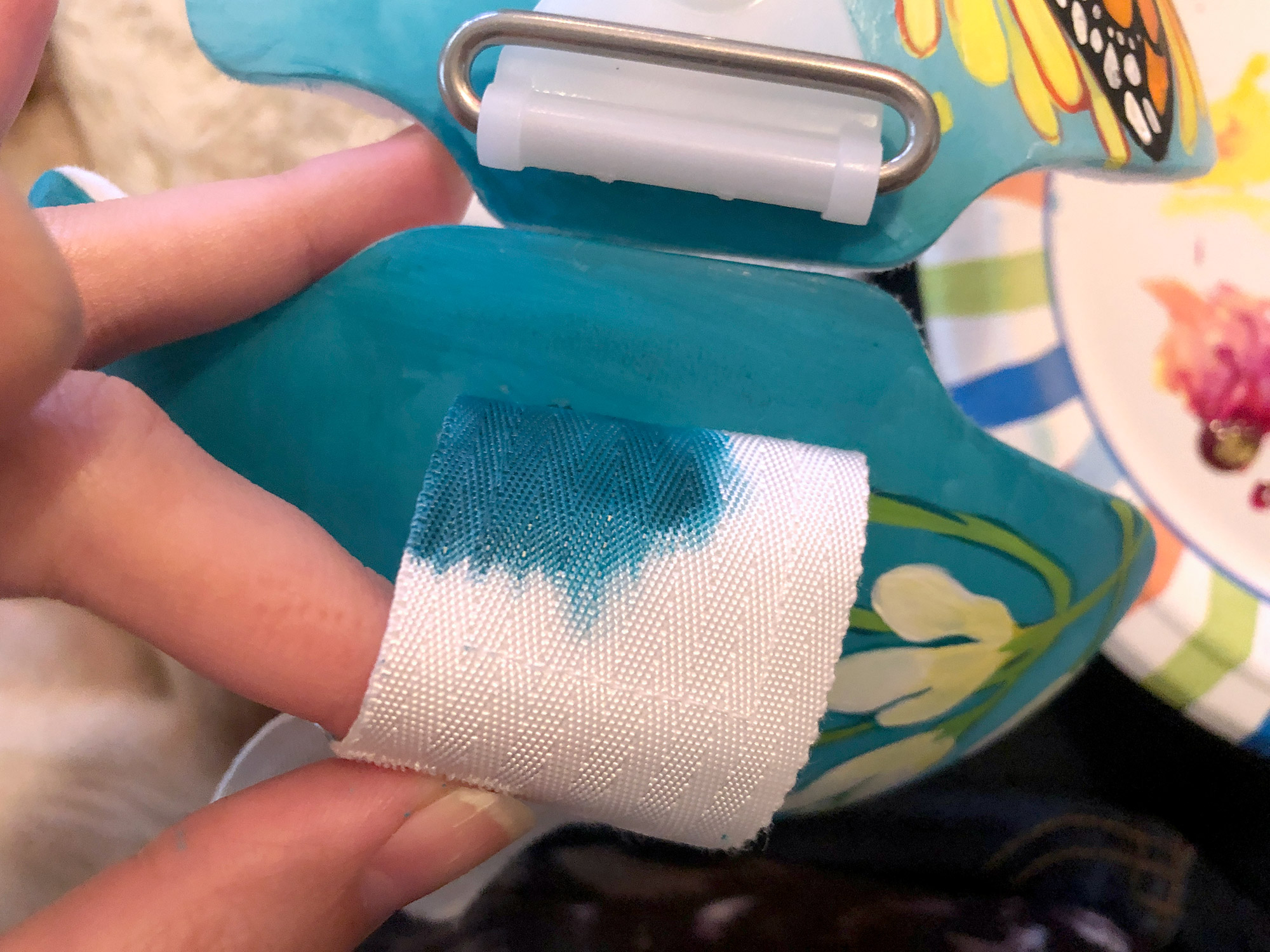
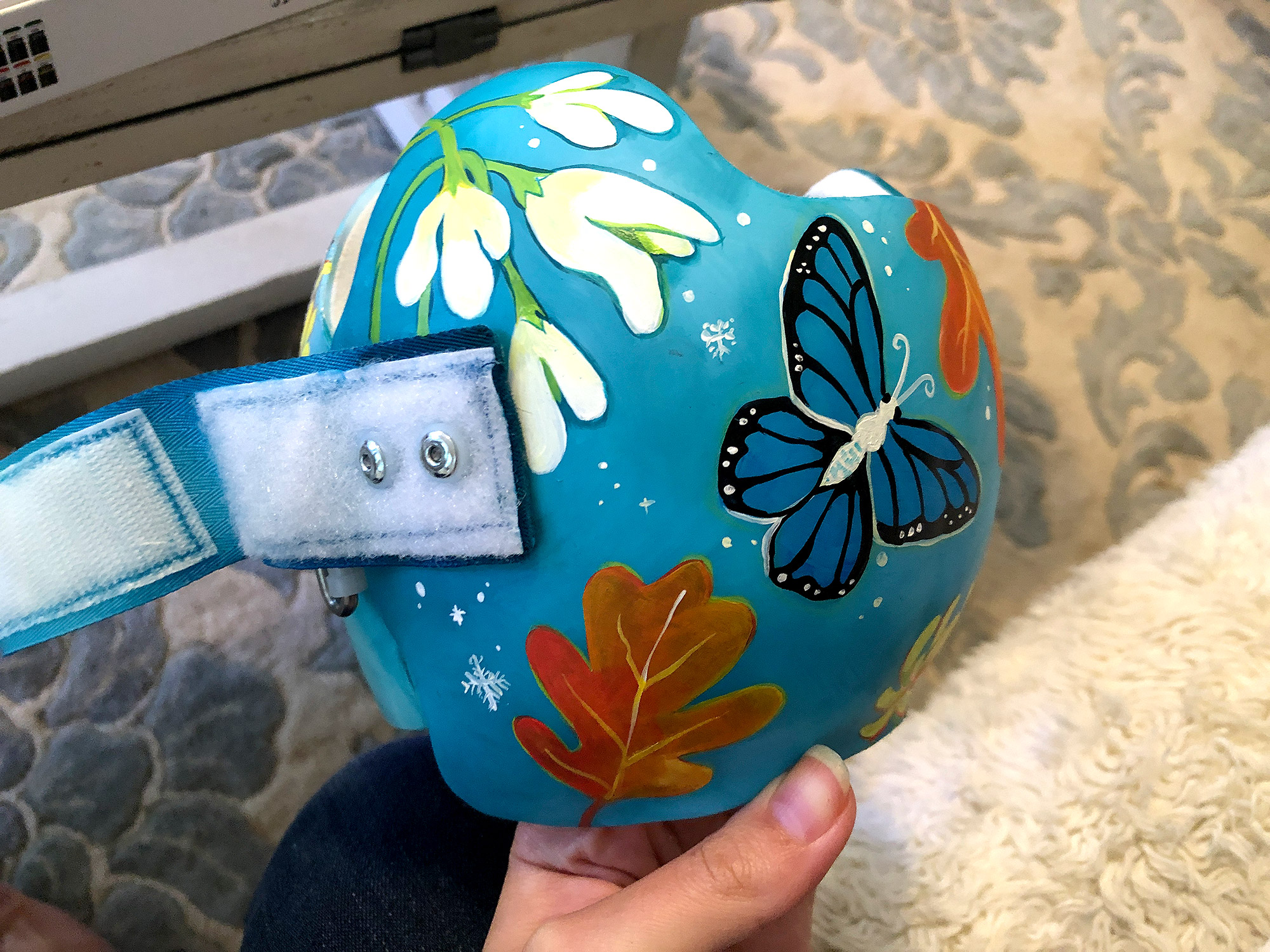
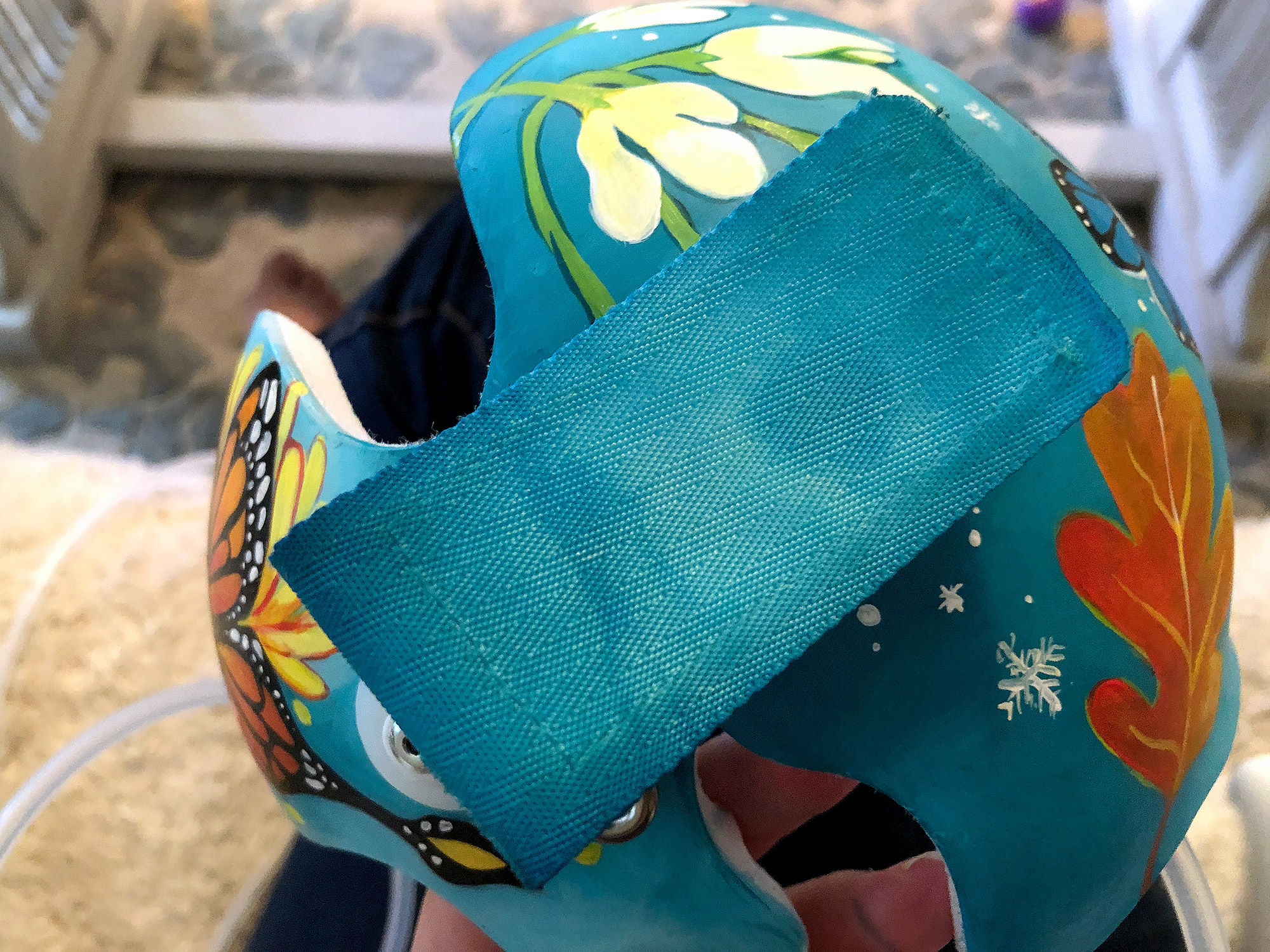


FINAL STEP: CLEAR COATS
This is essential. If you do not clear coat your helmet it will chip and flake off. Most people suggested 4-5 coats with a fresh coat every couple of weeks or so. I did this over a couple of days. Each day adding a coat when she was on her “hour or so break” from the helmet.
You can use gloss or matte, just make sure to brush it on evenly after everything beneath is fully dry. I then hung my helmet up by clipping the trap to a wire rack and putting a fan on. Modge Podge is nice and thick so it works great for covering the decals as well as it will “embed” them so the edges don’t stick out and get caught on things.

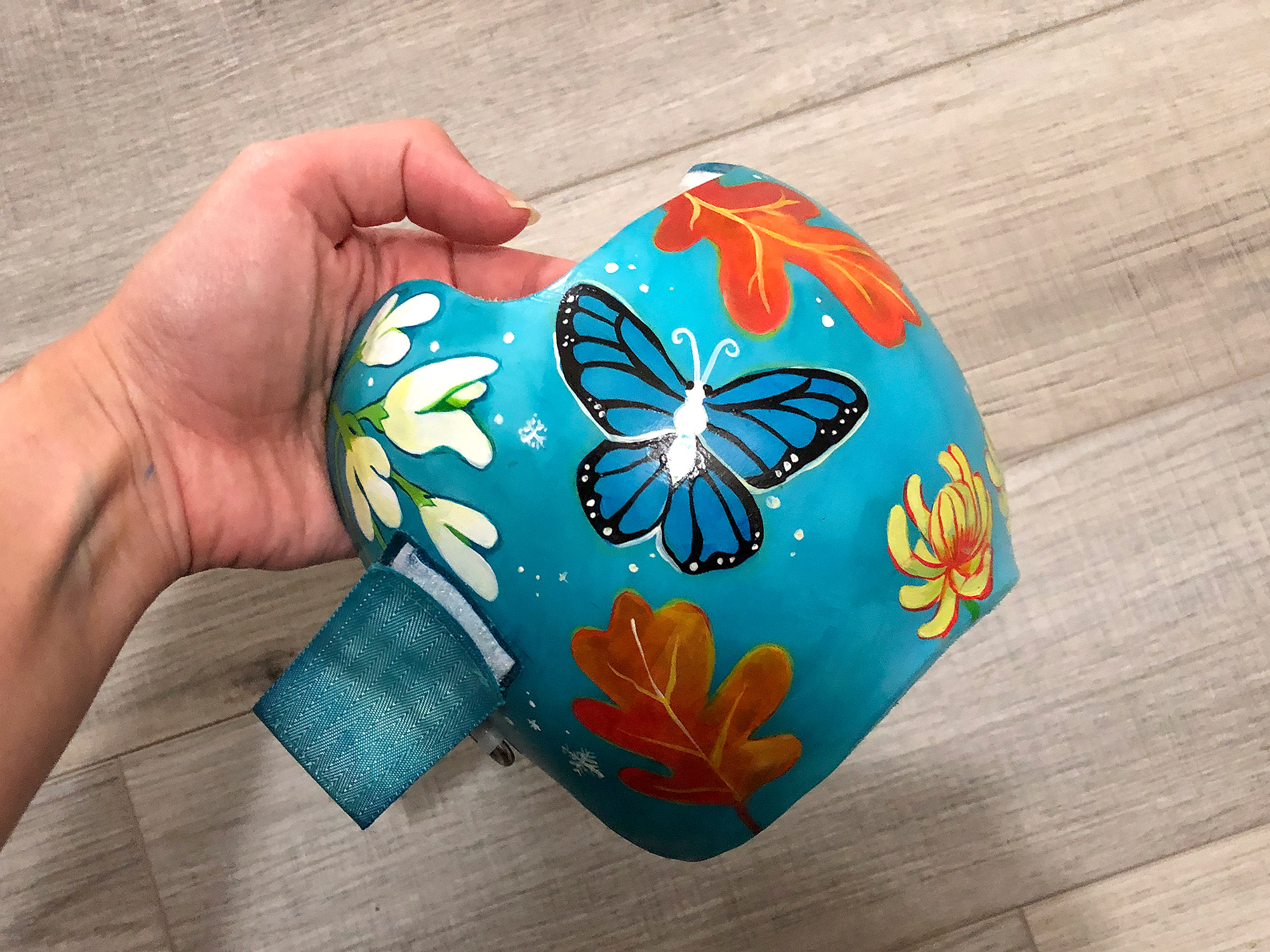

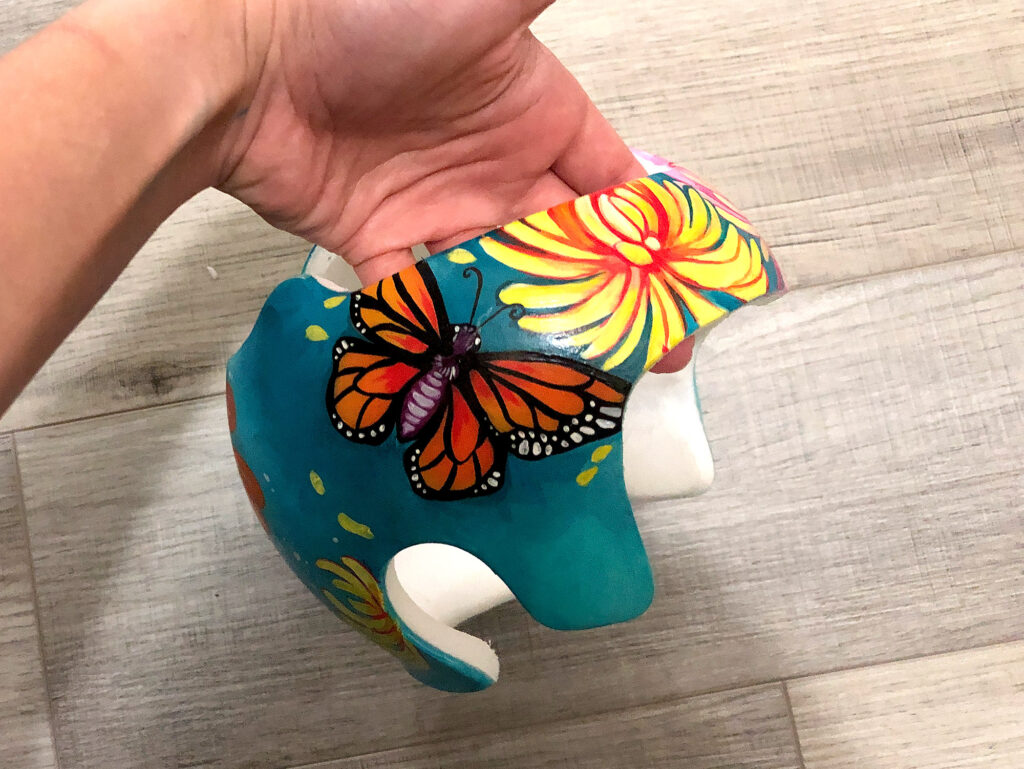

NAVIGATE POSTS
Helpful Links
Latest Posts
Posts by Category
Explore Posts By Tags
Acrylic Adobe Illustrator Alcohol Ink Baby Room Beginner Post Book Binding BuyTheFile Christmas Felt freefiles Gifts Gilding Glowforge Holiday Jewelry Journal Kaleidoscope LED Notebook Resin Rubber Stamp Settings Sign Stamping Yupo
Get Your Own Glowforge Laser
If you have found this post helpful and would like to purchase a Glowforge of your own you can receive a discount using my referral link when you are ready to purchase:
Sign Up to Blog Newsletter
CONCLUSIONS
Painting the helmet really cheered me up and made me feel better about my daughter needing to wear it. She looks so much cuter and people don’t act as weird about it when they see it. Some people don’t know what the helmets are for and assume the child has “something wrong with them” when really it’s just a simple, temporary orthotic device. Making it “pretty” really helps the conversation along. We even themed our daughter’s Halloween costume to match this year. She was a beautiful “booterfly” haha! Mommy (me) was a giant sunflower and daddy was a very minimalist bee.
Bonus update – a few years later my son also needed a cranial band so now I have done this twice! I chose an under the sea theme for my son since we live by the beach and its summer.
FINAL TIPS:
- If you plan to paint yourself put your money into the quality paint itself – brushes and Modge Podge are cheap. Better paint means better coverage and a brighter more durable result.
- COAT THAT SUCKER – you essentially cannot do too many Modge Podge coats. I did four but plan to add a new coat each week.
- Prep matters – properly sanding is probably the most important step. The areas I missed were difficult to work on.
- Don’t be afraid to do this in stages, I painted the front of the helmet one day and the back the next.
- Let it dry between layers – acrylic paint dries pretty fast, but you can speed the process with a fan. Let each layer dry before moving on, you can jump around to different areas of the helmet like I did but if you try and layer too fast it’ll get muddy looking.
- If you hate it just sand it off! You can scratch away mistakes with a razor blade or sand them off if you hate the design. Ideally, do this before clear coating.
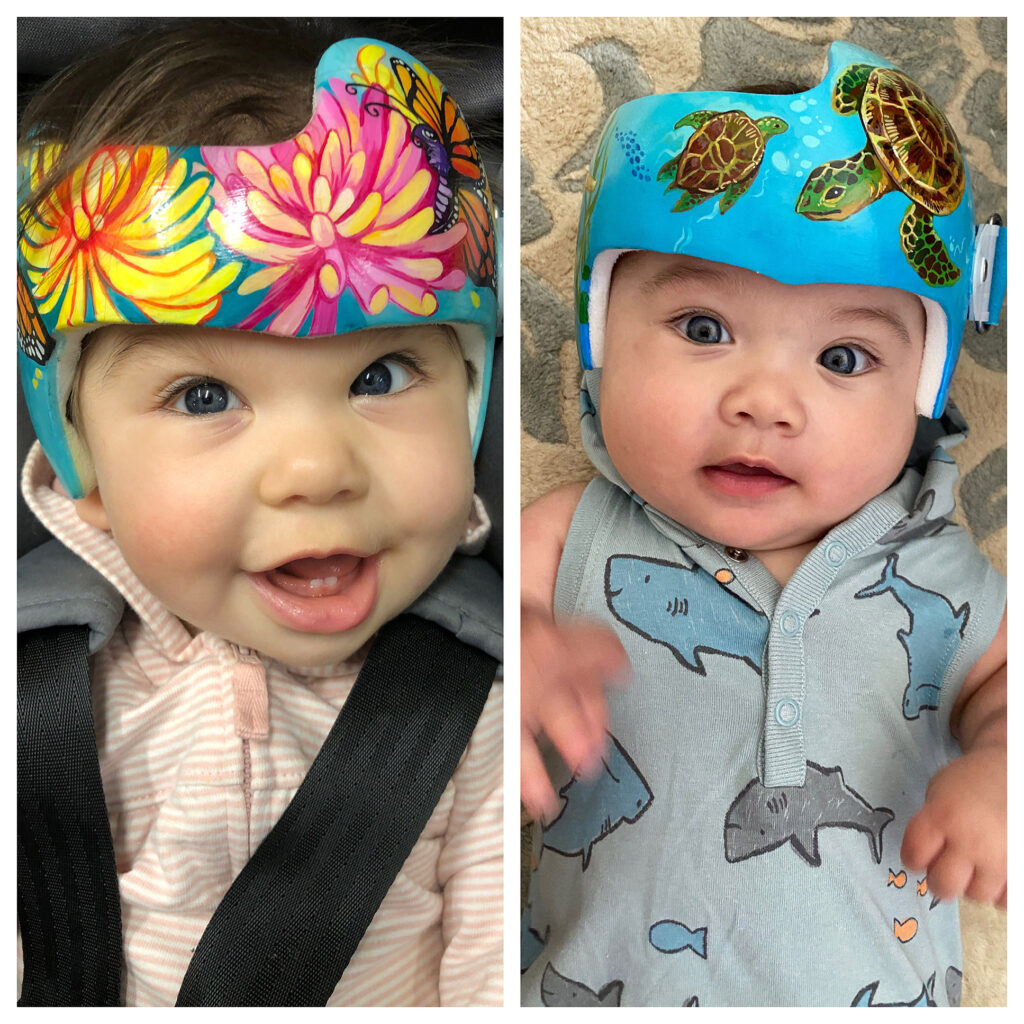
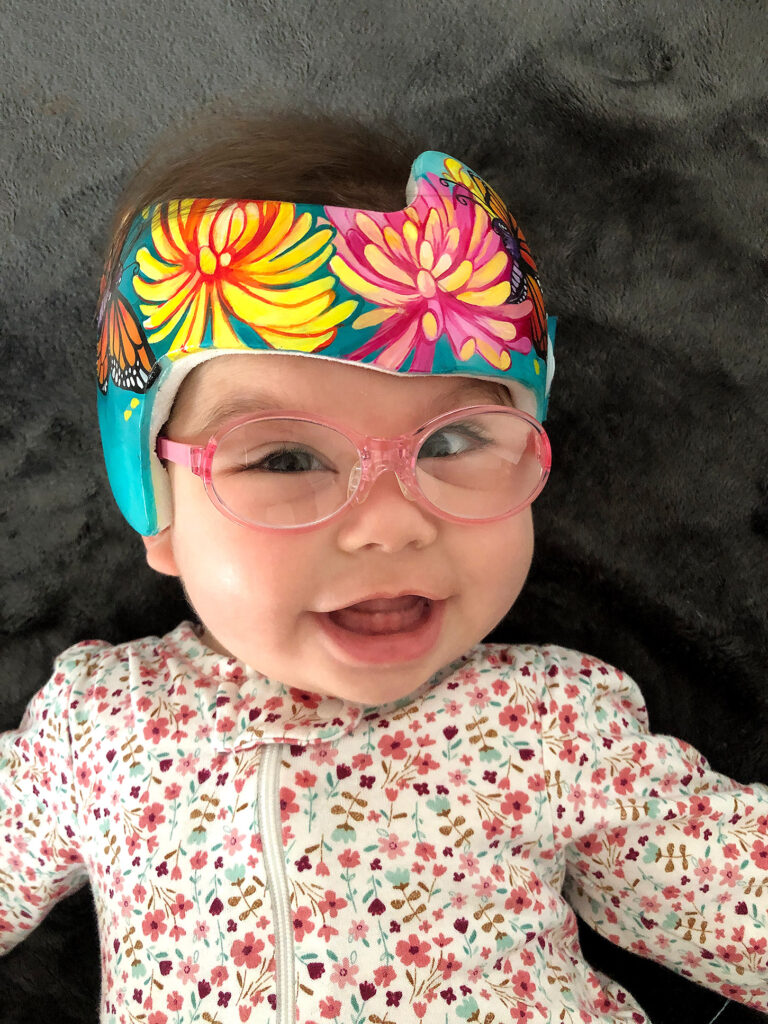
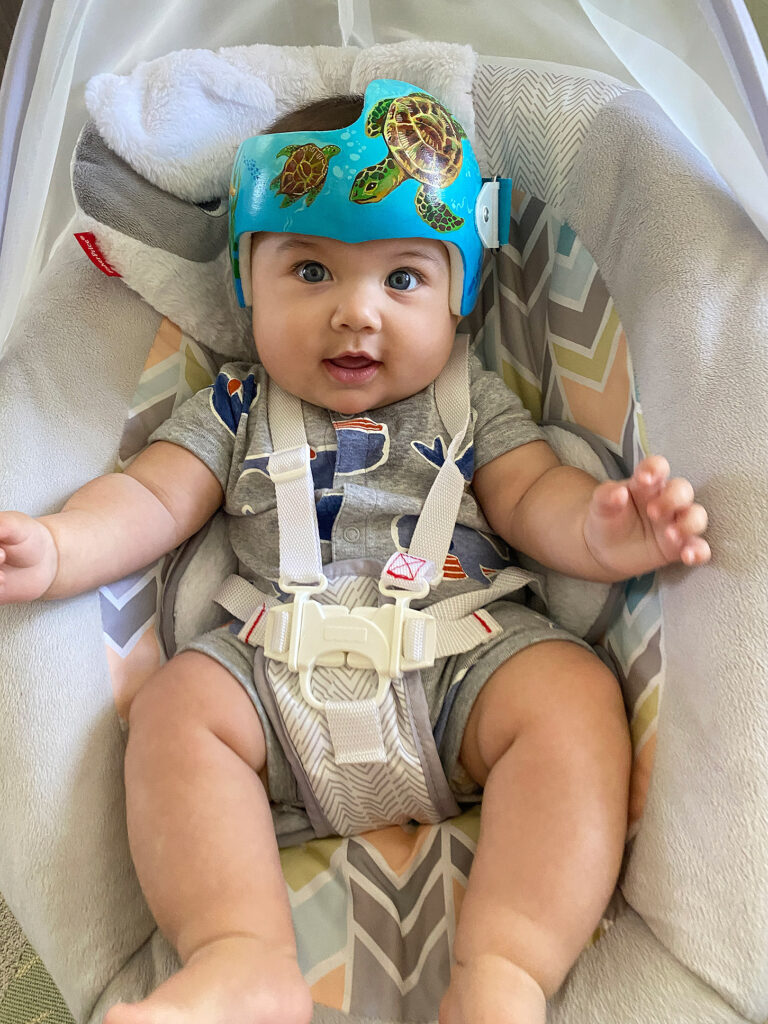
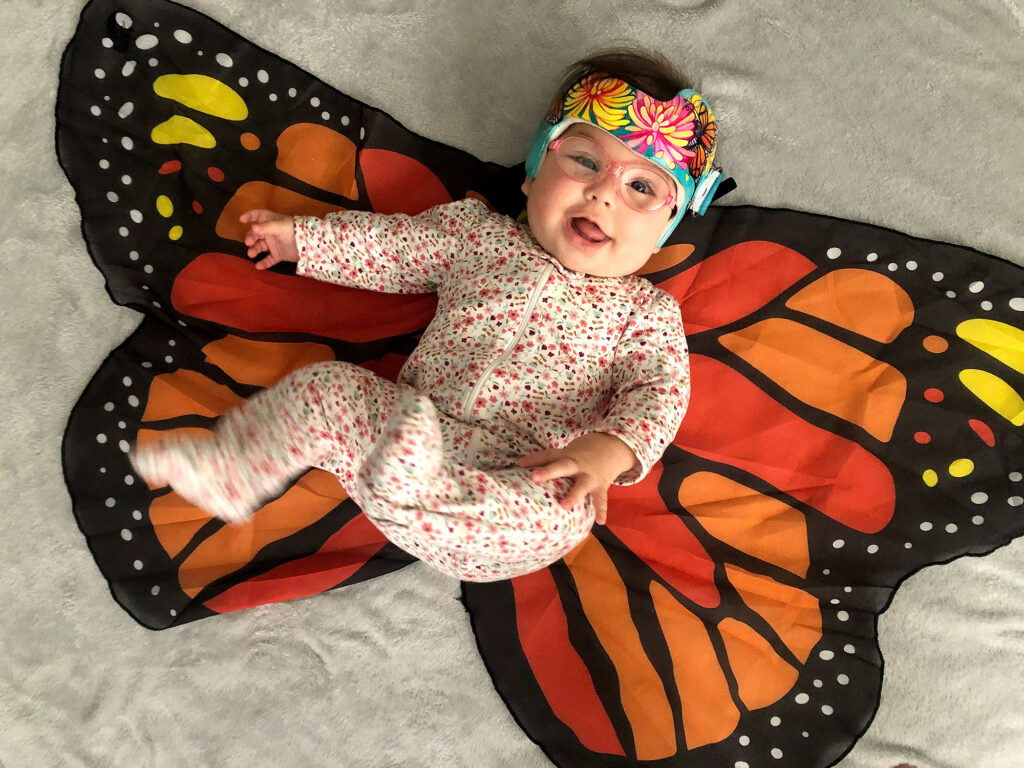

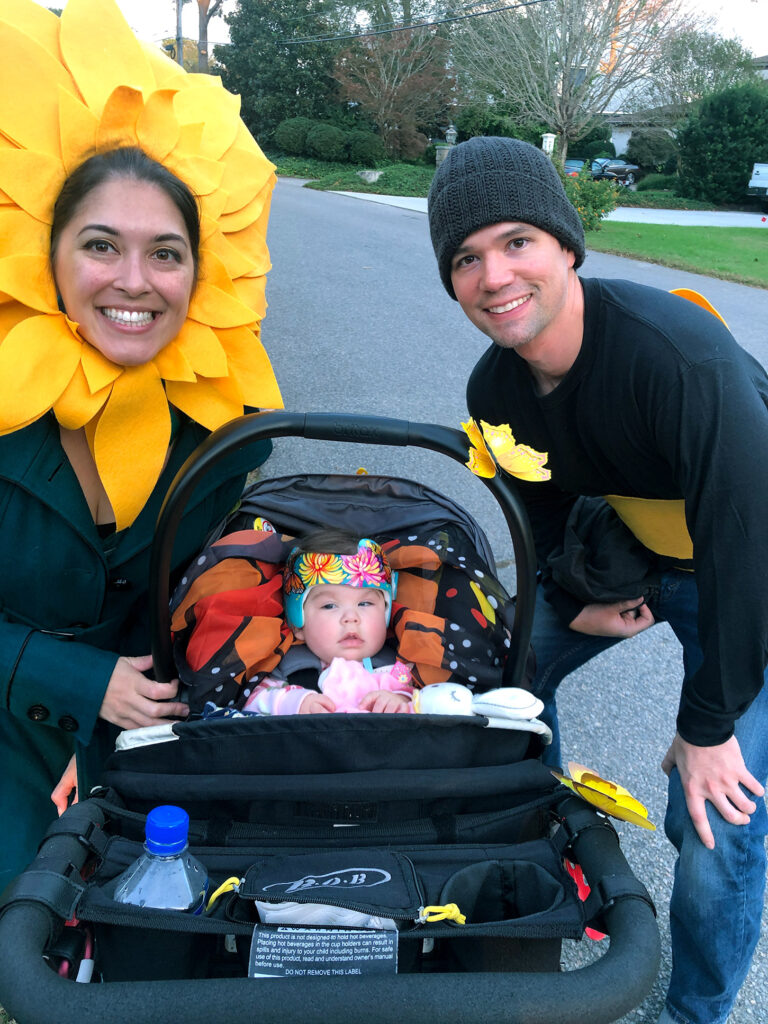
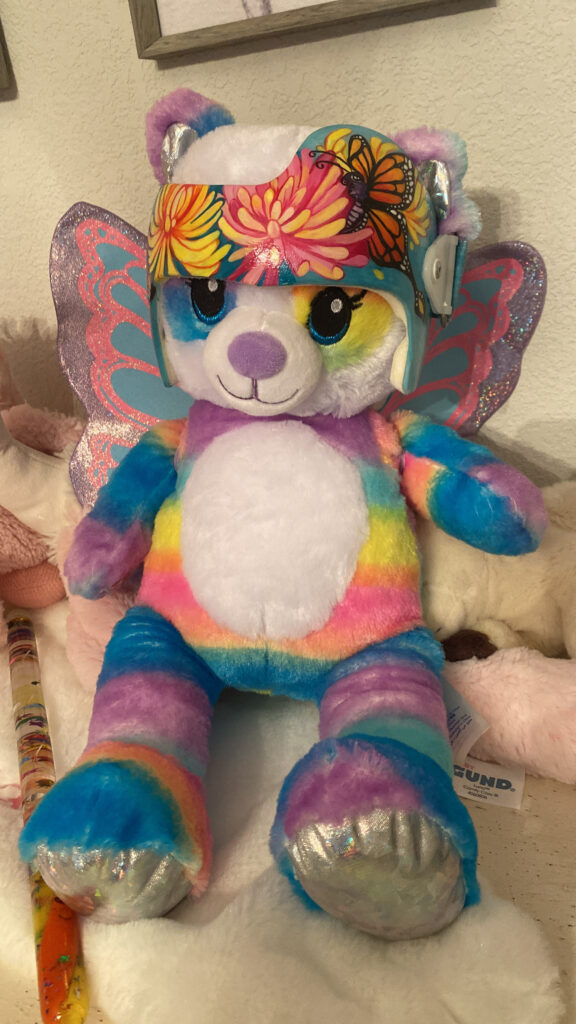
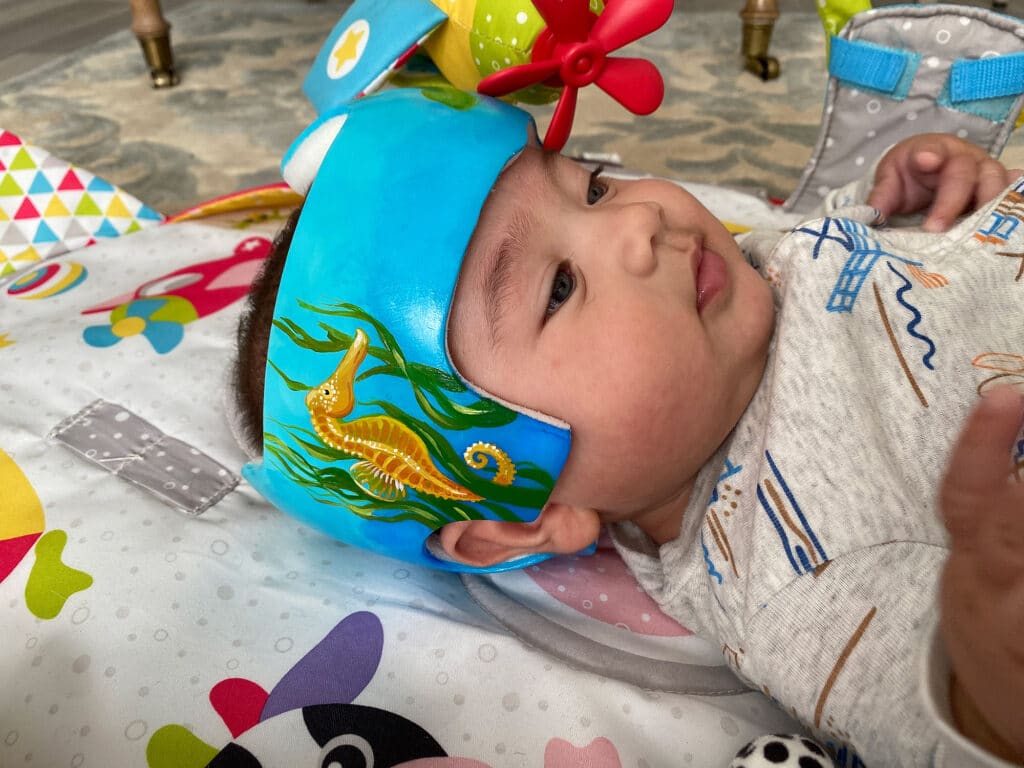
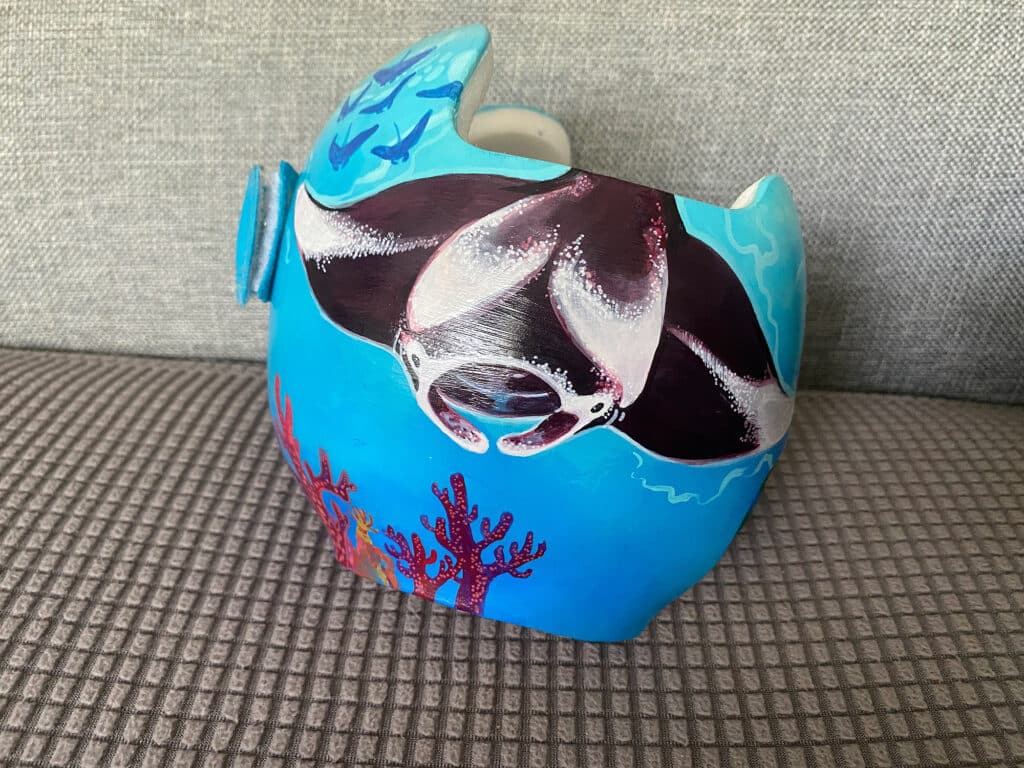
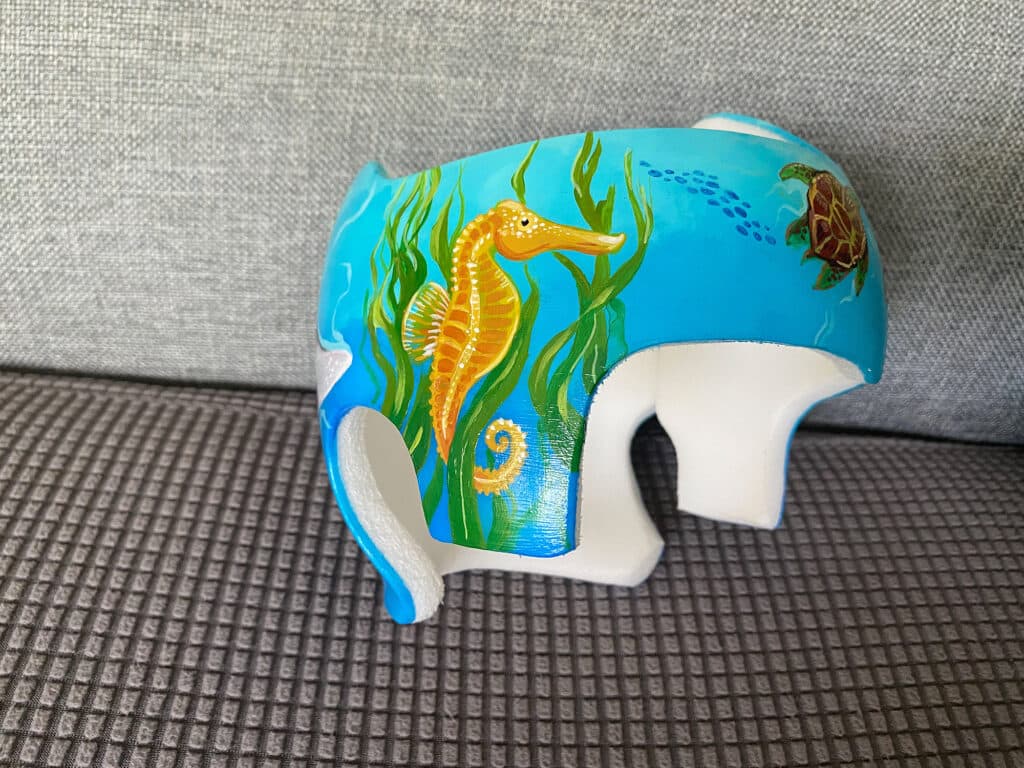
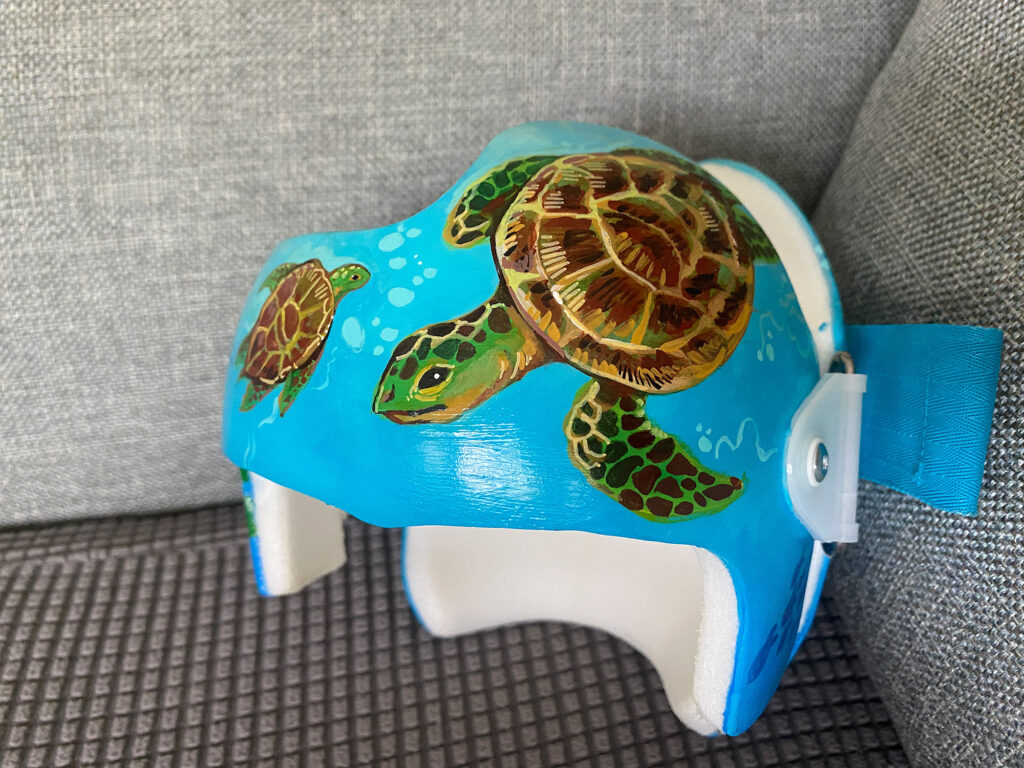
Where to Get the Materials:
Some of these are Amazon affiliate links, so feel free to skip them if you’re not into that. As an Amazon Associate, I earn from qualifying purchases, but they do not cost you any extra:
Get 50% off your first Wish.com order with my code: mfvjgnw | I buy lots of odds and ends here, so if you need some small item and don’t mind waiting, this can be a fun shop to check out.
Acrylic Gouache: A really nice high-quality paint. It comes in smaller sets but this is the set I sued. A little goes a long way.
Modge Podge: I used a gloss, but you can also use matte.
Golden Fluid Acrylics: Great in addition to the gouache but I would not use these on their own for this project.
Cheap Brushes: I used these along with a few random ones I had lying around.
Obligatory Glowforge Discount Code Plug
If you found this post helpful and you plan to buy a Glowforge you can use my code (https://glowforge.us/r/QHDONFXB) for a discount of $100 off the Basic, $250 of the Plus, or $500 of the Pro:
Sign Up for Blog Posts Updates
And finally, if you’d like to be updated on posts like these in the future you can sign up for my email list. You will only receive an email if there is new content, and only once weekly in that case:

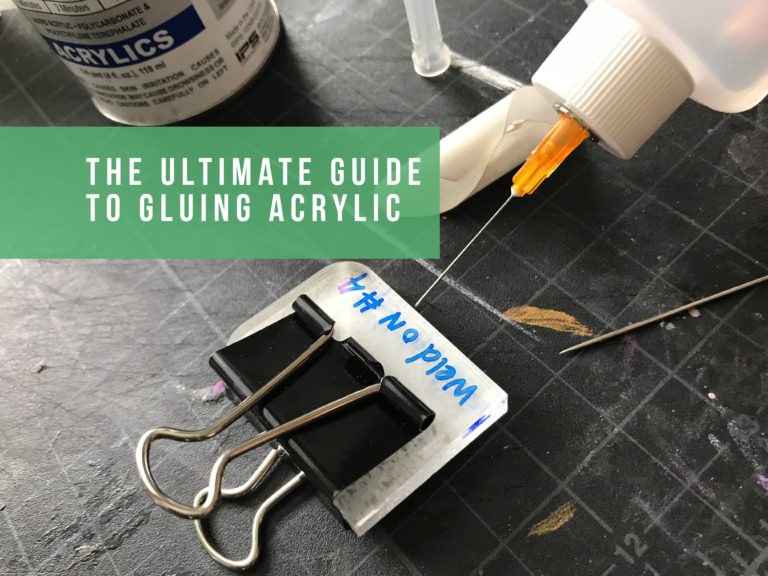
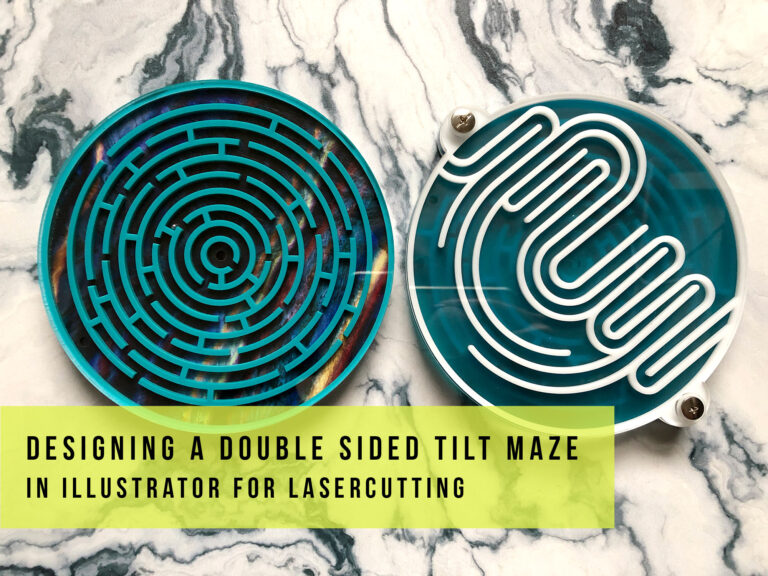
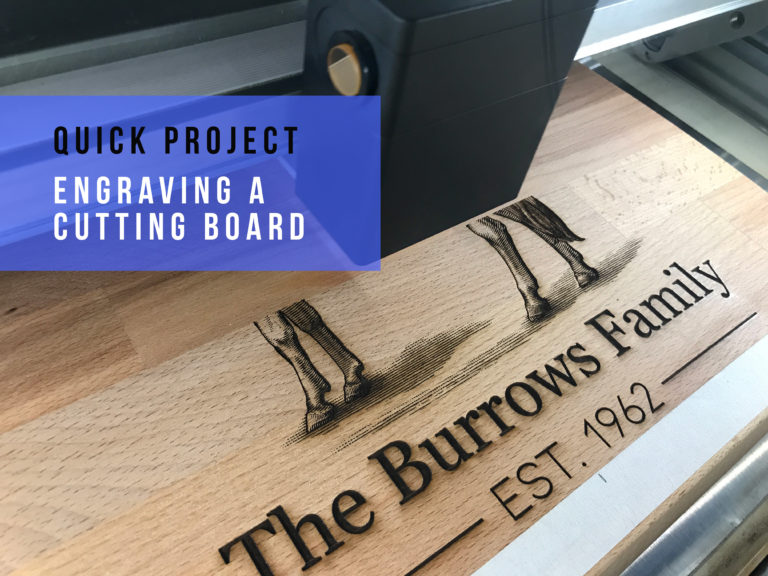
Beautiful! Thank you for sharing. 😍
Hello!
Beautiful design!
How long after painting the helmet did you wait before you put it back on your child’s head?
Maybe 15-20 minutes? The acrylic and clear coat are non-toxic so I just waited for it to dry essentially.
Love the helmet!!! I want to buy good paint, but I don’t think Liquitex is non-toxic? Or cadmium free?